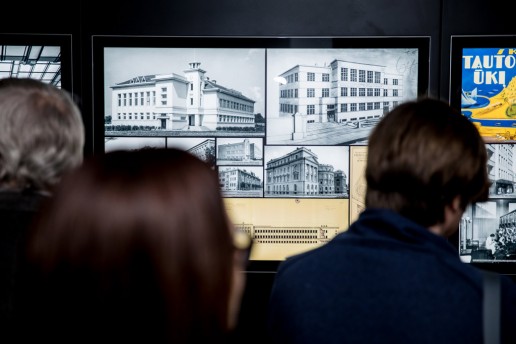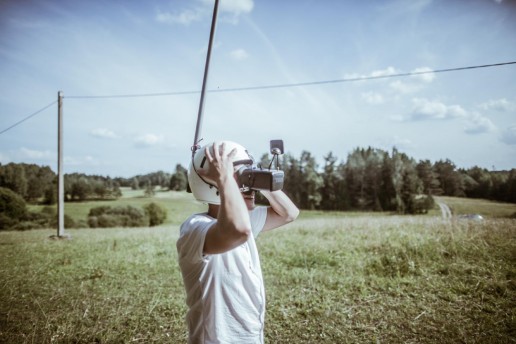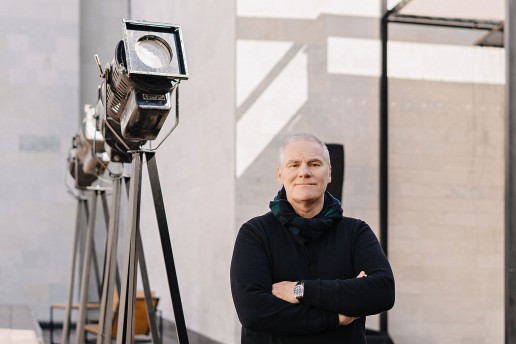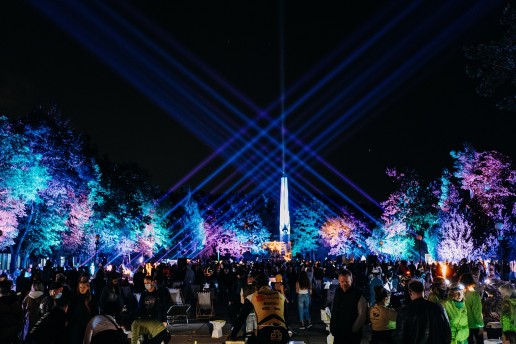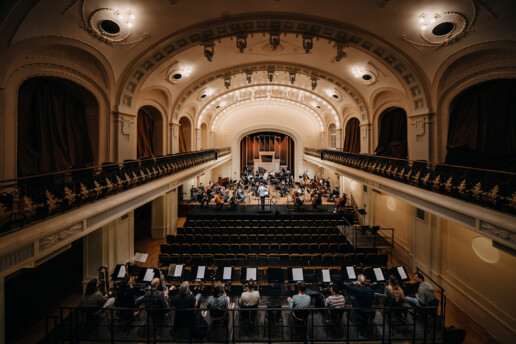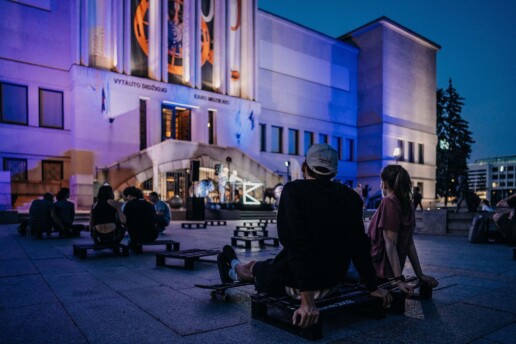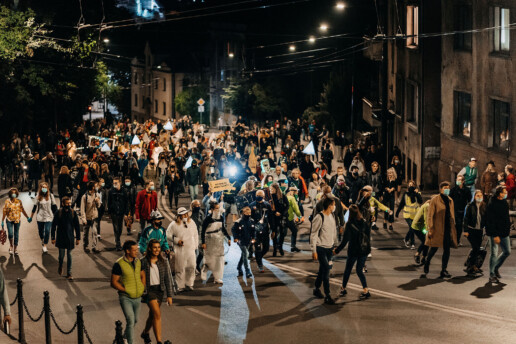Exhibition: Architecture of optimism - The Kaunas phenomenon 1918-1940 / Unité d'Habitation Le Corbusier, Marseille
"Architecture of Optimism: the Kaunas Phenomenon, 1918-1940" will be on display at the "Kolektiv Cité Radieuse" Gallery, located within Le Corbusier's Unité d'Habitation in Marseille, from December 11, 2021 to January 9, 2022 and will start the European Capital of Culture year Kaunas 2022.
The city of Kaunas is renowned for its unique fusion of history and creativity through architecture and design.
The city's golden age between the two world wars was marked by modernist architecture that transformed Kaunas into a forward-looking European metropolis, reflecting the forward-looking optimism and hopes for cultural, social and technological innovation of the time.
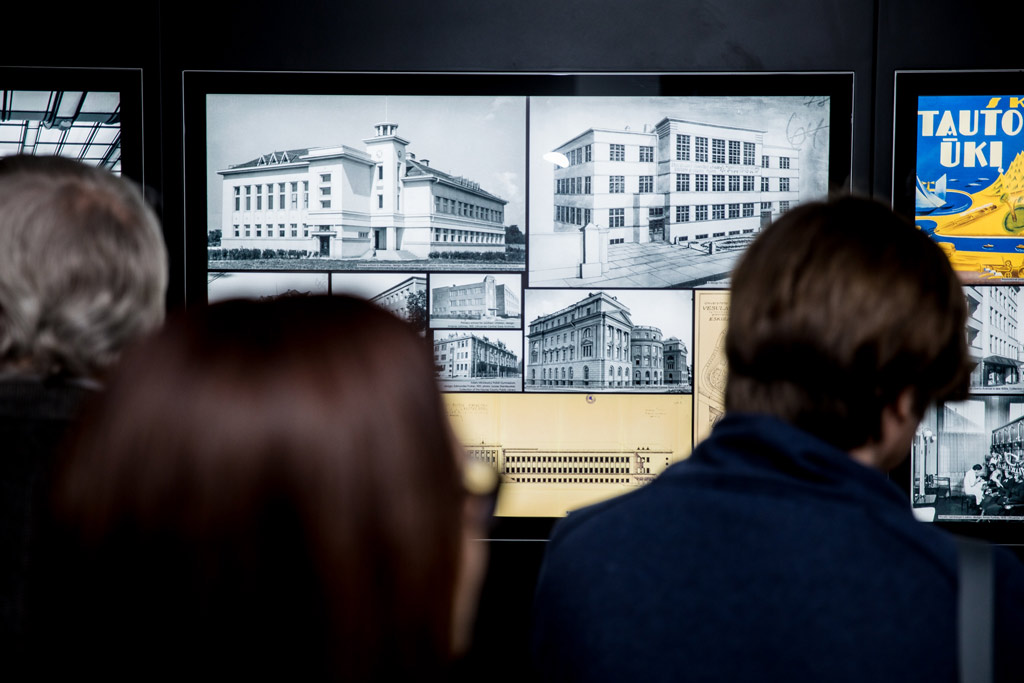
During this period, Kaunas changed its physical, historical and cultural identity considerably: in less than 20 years, its inhabitants built more than 12,000 new buildings, reshaping the whole city. This regeneration was the new heritage of Kaunas and the expression of its genius loci.
After the Second World War and during the Soviet occupation, Kaunas' interwar modernist architecture provided a vivid memory of the former state, a symbolic window to the West, and became an architectural reference for Soviet architects.
The exhibition celebrates the architectural history of the city but also rewards and revives the optimistic vision of this period by strengthening the cultural life, community building and physical and social innovation of Kaunas.
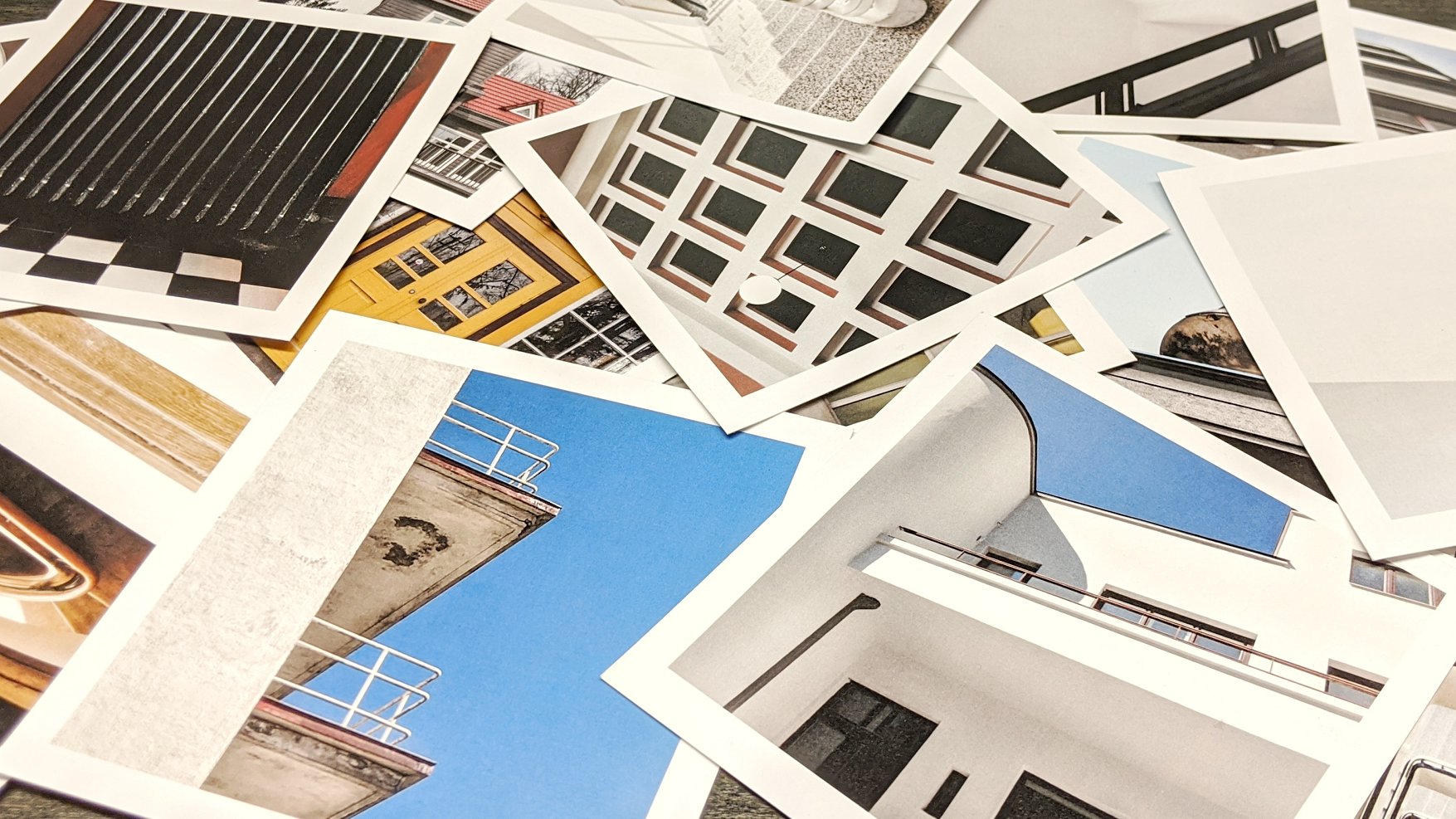
Address :
Galerie Kolektiv Cité Radieuse - Unité d'Habitation Le Corbusier
280 Bvd Michelet, 3rd floor no.313, 13000 Marseille
Tel : 0624686670
Timetable : Wed-Sat : 10h00-18h00 / 11 December 2021 - 9 January 2022
Curator : Marija Dremaite with Vaidas Petrulis, Giedre Jamkeviciute and Matas Siupsinskas
Coordinator: Vaiva Marija Bružaitė
kaunas2022.eu | www.modernizmasateiciai.lt
Estonian art and tech farm Maajaam announces an international open call for the technological art exhibition Wild Bits
Estonian technology and art farm Maajaam announces an open call for artists to participate in the residency Wild Bits that will culminate with an outdoor exhibition in the surrounding hill country of Otepää, South Estonia. Wild Bits is part of the main programme of the European Capital of Culture Tartu 2024.
Art projects are expected to be produced during the 3-week residency period in the summer of 2022 and exhibited in the natural landscape around Maajaam. This is the first open call to find works for the Wild Bits exhibition programme taking place from 2022 to 2025. The created works will remain there in Maajaam to be exhibited at the main exhibition of Wild Bits in the summer of 2024 as well as in satellite exhibitions in Estonia, Latvia and Lithuania until 2025. One artist will be selected from Lithuania as the residency is co-funded by Kaunas 2022 European Capital of Culture. The collaborator from Lithuania will be the landscape design festival Magenta, official partner of Kaunas 2022. The Magenta festival will present 3 of the selected works to Lithuanian audiences in September 2022.
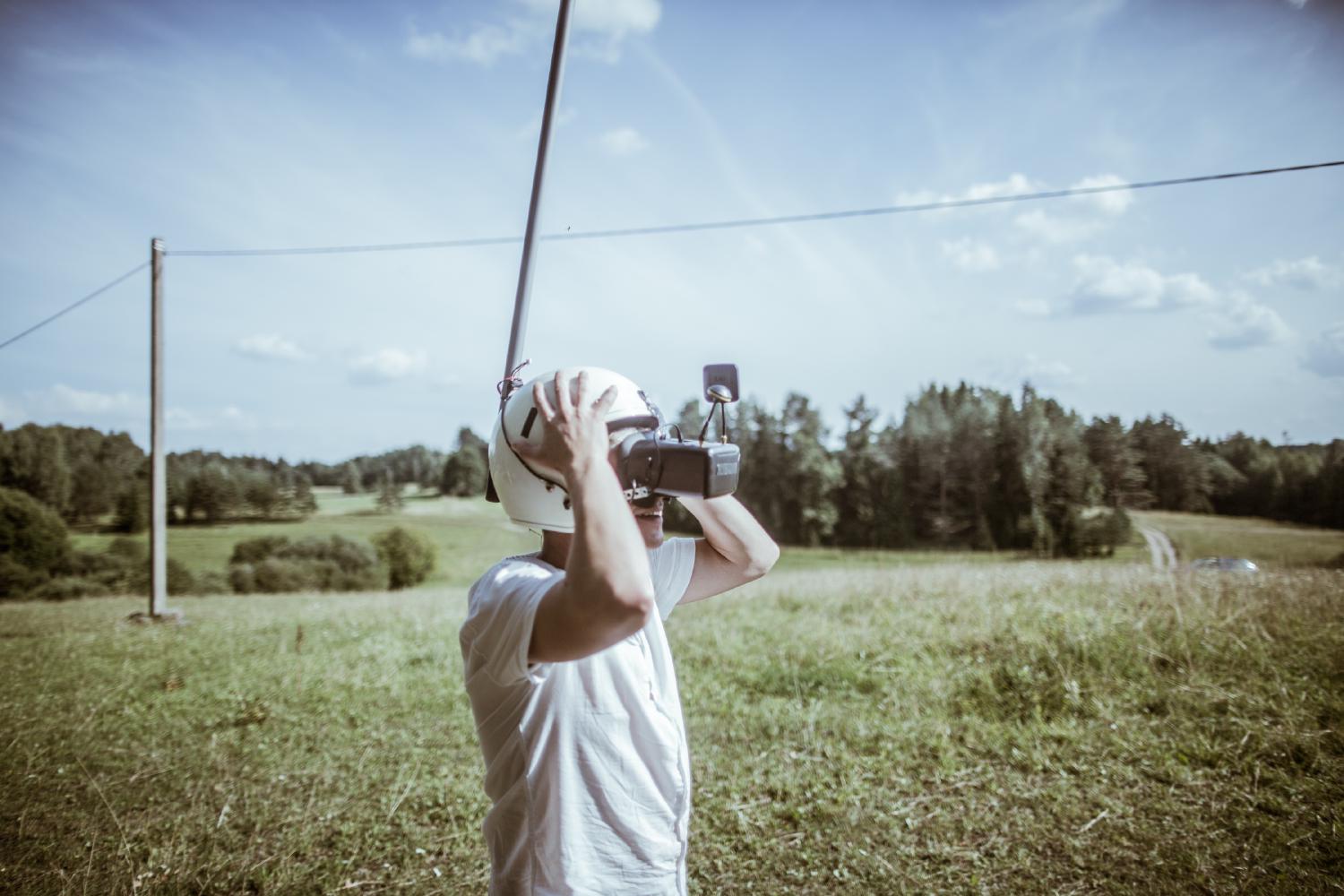 Maajaam is looking for art projects that explore the human condition in a contemporary technological society and look at points of contact between people, technology and nature. The artworks should fit into the diverse landscape, which includes areas of forest, meadow and swamp and bodies of water - a creek and a lake. The artworks should withstand outdoor conditions. Both Estonian and foreign artists from various disciplines are welcome to participate.
Maajaam is looking for art projects that explore the human condition in a contemporary technological society and look at points of contact between people, technology and nature. The artworks should fit into the diverse landscape, which includes areas of forest, meadow and swamp and bodies of water - a creek and a lake. The artworks should withstand outdoor conditions. Both Estonian and foreign artists from various disciplines are welcome to participate.
“Maajaam invites us to dream, research, invent and create new possibilities for people to positively survive the seemingly gloomy future ahead”, says artist Timo Toots.
Projects are selected by the panel that includes the artists operating Maajaam
Timo Toots and Mari-Liis Rebane, artist Taavi Suisalu, the organisers of the site specific urban festival UIT Kadri Lind and Marie Kliiman. This year's guest panel member is Gediminas Banaitis-Skrandis from Kaunas 2022. Three to five projects will be selected for the residency of 2022. Selected projects will receive an artist fee of €2000, and the production budget is up to €5000. Transport and accommodation for participants will be covered to the extent agreed upon. Wild Bits residency and exhibition programme is co-financed by Tartu 2024 - European Capital of Culture. The satellite exhibition in Kaunas in 2022 is supported by the Estonian Cultural Endowment and Kaunas 2022 - European Capital of Culture.
Submissions are accepted until December 12, 2021 and selected projects will be announced in January 2022.
For more information on applying and participating - click on this link
MAAJAAM
The small art center called Maajaam (Earth Station in Estonian) is situated in Otepää nature reserve in South of Estonia in an old farm. The buildings previously used for agriculture have been converted to host a high-tech art studio and residency house for artists. Maajaam is run by artists Timo Toots and Mari-Liis Rebane.
www.maajaam.ee
Exceptional achievements of Kaunas modernist architecture and design reached Bilbao Design Week
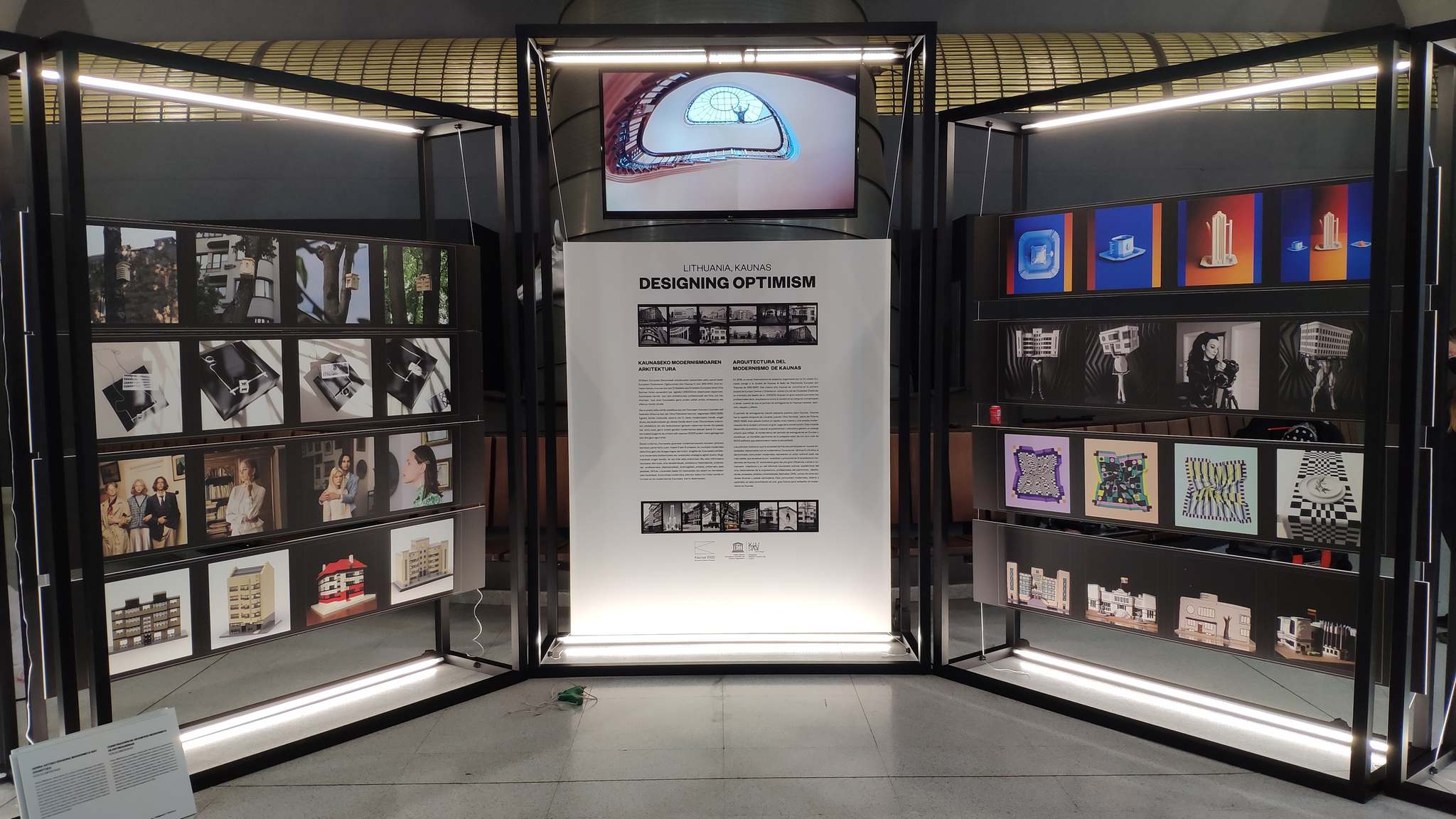
With the rapid approach of 2022 - the year of the European Capital of Culture, Kaunas is increasingly representing itself on international city platforms. The artists of Kaunas travel thousands of kilometers to show off their work. Currently, Bilbao Bizkaia Design Week takes place on November 18-25, where you can get acquainted with the creators of Kaunas and the activities of Kaunas 2022.
Bilbao Design Week is an annual event that aims to promote the creative industries sector through conferences, lectures, workshops, presentations, and meetings in various parts of the city and involves multiple cultural institutions, associations, universities and creators, and artists. This year's theme, Crossings & Transitions, examines the current period, with a particular focus on climate change, socio-economic and health crises, aging of the population, technological progress, and digital transformations that are pushing the world into new everyday perspectives, sustainability, accessibility, and creativity.
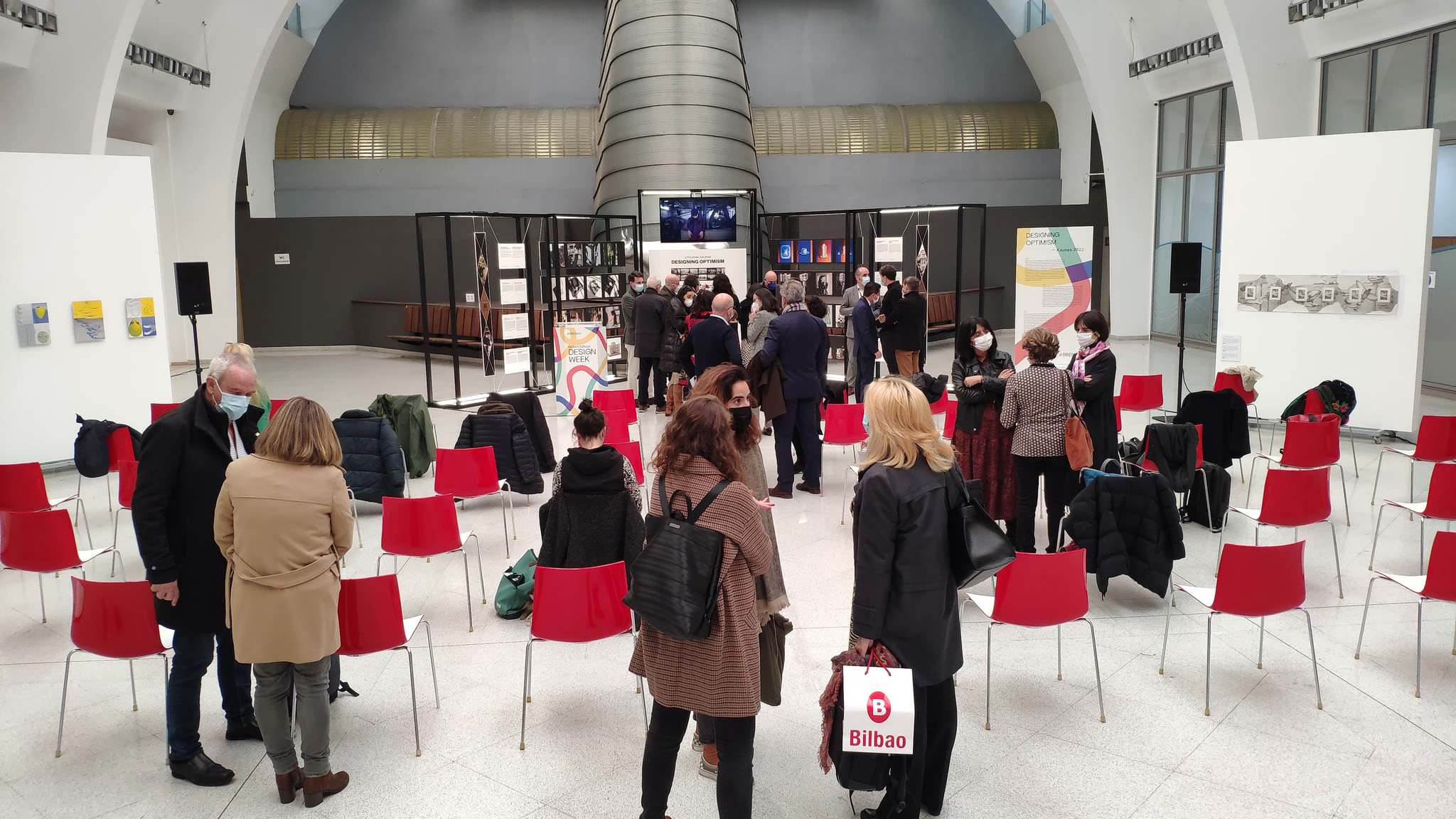
During the Design Week, it will also be possible to get acquainted with the plans and achievements of Kaunas - the European Capital of Culture, the identity revealed through interpretations of design and architecture, and hear the presentations of Gintaras Balčytis and Gerda Liudvinavičiūtė, as well as learn their sources of creativity and inspiration. Furthermore, modern architecture and design peculiarities were on display at the Guggenheim Museum and contemporary art and leisure center Azkuna Zentroa.
Creators and culture lovers from all over Europe are interested in Kaunas' activities and topics, so Bilbao's Design Week also includes an exhibition "Designing Optimism" created by Gediminas Banaitis, which features Modernism for the Future projects and interpretations of modernism architecture revealed by Timtiejus Norvila - Morfai, Gerda Liudvinavičiūtė[Celsius273], youth project Komoda, Mantas Kuginis, director of the film "Pleads" Aideen Barry, Studio Falbanka, Kaunas Food Industry, and Trade Training Center project portraying modernist buildings in cakes, Rokas Mikšiūnas and a joint project by LRT and Lithuanian dance information center "Contemporary art and architecture. "

Since 2015, Kaunas has been participating in the initiatives of the UNESCO Creative Cities Network and sharing contemporary culture with the world. By joining the Network, cities reaffirm their commitment to sharing best practices, developing partnerships that foster creativity and the design industry, and strengthening participation in cultural life. In recent years, Kaunas has participated in many international initiatives that promote the recognition of the importance of design in the city, and participation in the activities of the UNESCO Network of Creative Cities has become more active.
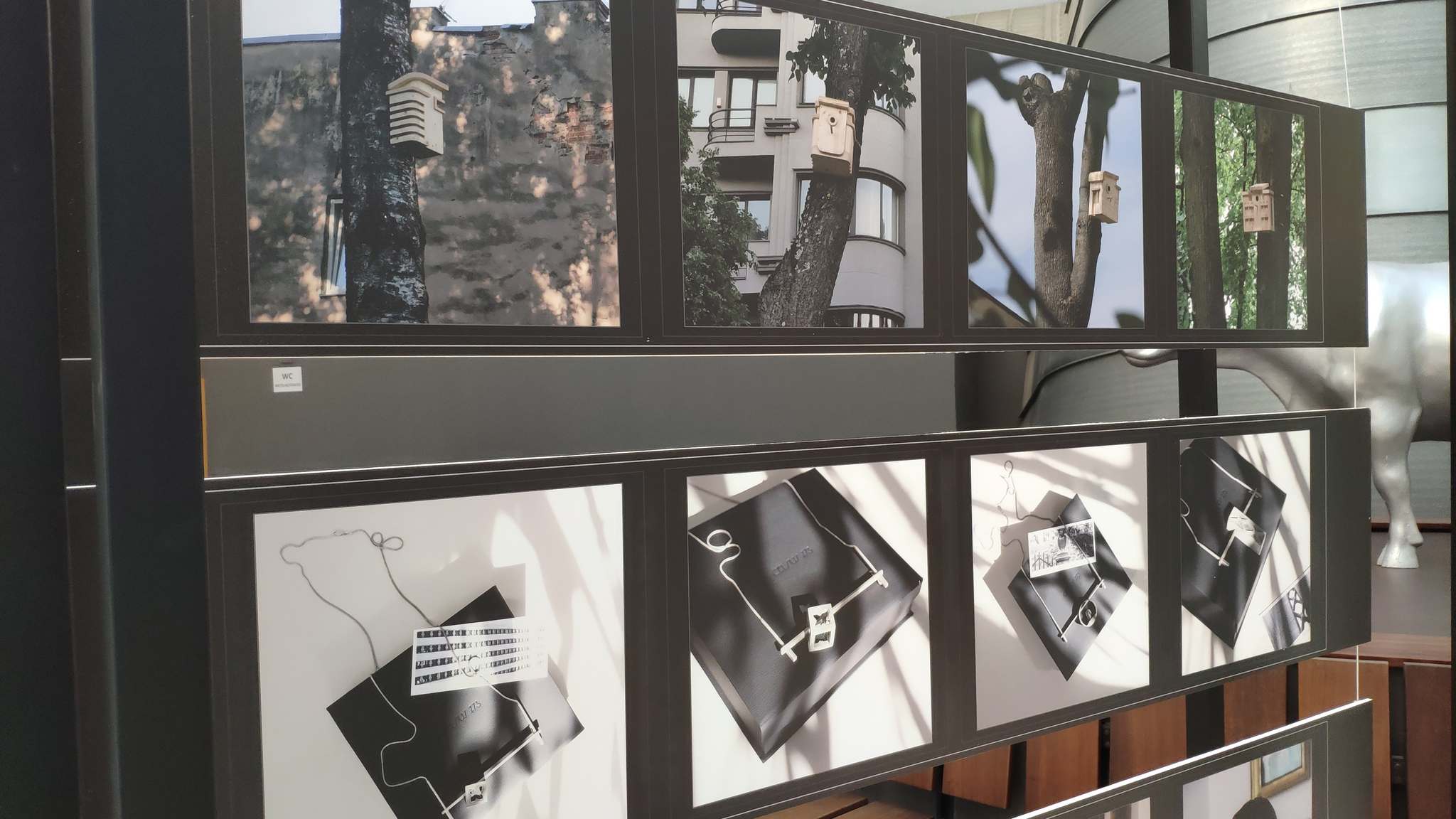
Chris Baldwin: Breaking down a boundary and stereotype means to actively help in the process of making new meanings, more useful cultural works
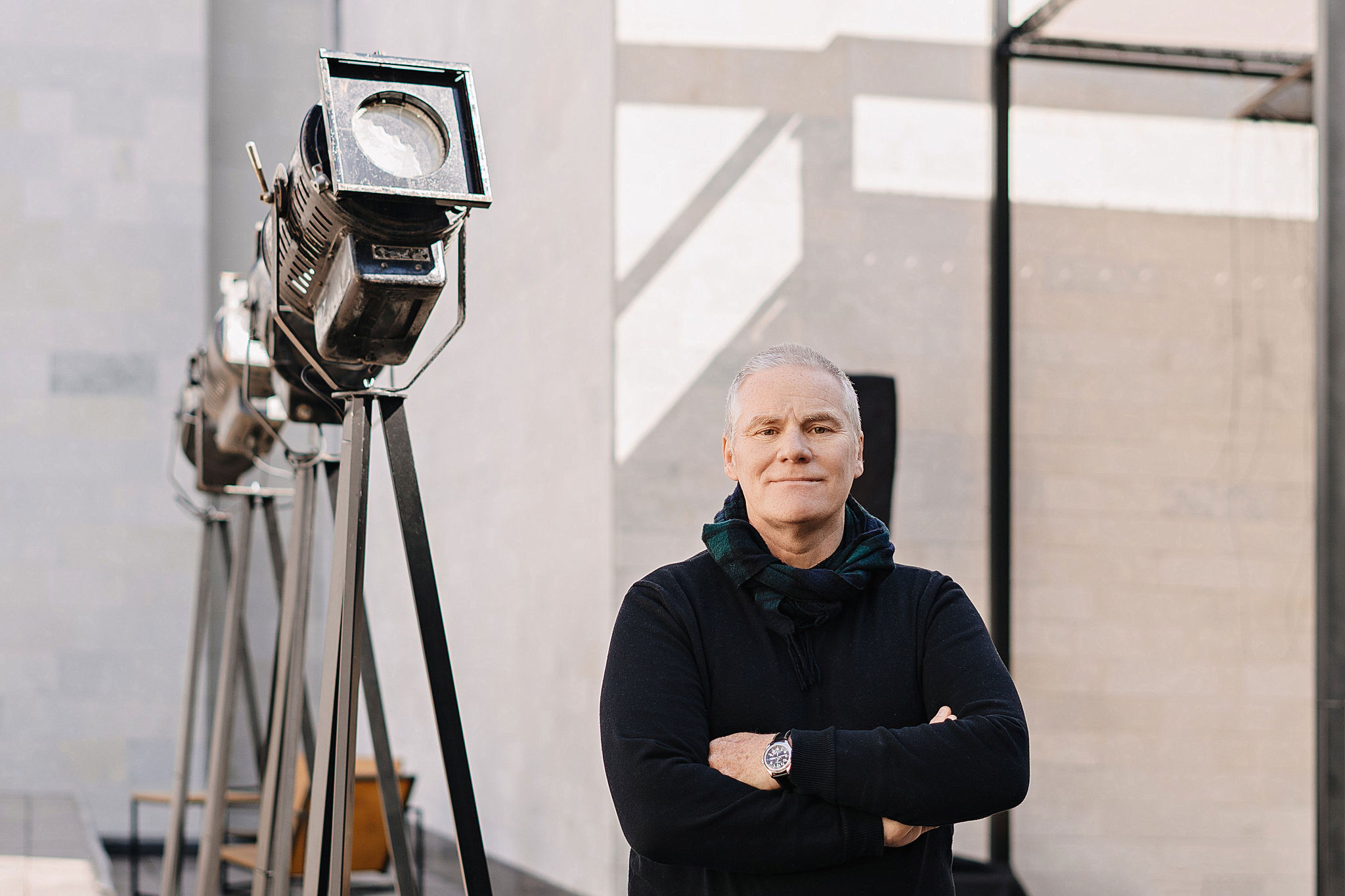 Chris Baldwin is a director, writer, curator… But he is so much more than these definitions. For many years now he has worked across the continent and has added to the success of a handful of European Capitals of Culture. This experience, together with his natural openness to the world and its cultures, make Chris a true European. No wonder the artist was invited to co-create the unique symphony “Šaipėrantas” (composed by Antanas Jasenka, conducted by Modestas Pitrėnas) for the grand opening of Kaunas 2022 on January 22 at 7:30 pm. The director got to know Kaunas intimately during this process – he also agreed to tell us more about his understanding of Europe and Europeanness.
Chris Baldwin is a director, writer, curator… But he is so much more than these definitions. For many years now he has worked across the continent and has added to the success of a handful of European Capitals of Culture. This experience, together with his natural openness to the world and its cultures, make Chris a true European. No wonder the artist was invited to co-create the unique symphony “Šaipėrantas” (composed by Antanas Jasenka, conducted by Modestas Pitrėnas) for the grand opening of Kaunas 2022 on January 22 at 7:30 pm. The director got to know Kaunas intimately during this process – he also agreed to tell us more about his understanding of Europe and Europeanness.
Below is an interview with director Chris Baldwin.
- Being British, how did you start working in countries that are considered post-soviet or post-authoritarian? Was it an adventurous decision?
- Ahh. Being British! I don’t really know what that means. I was born in Oxford in the early 1960’s. I was the younger one of post-war siblings. So we grew up with quite a strong sense of what being British was supposed to mean. We had, after all, with the Americans helping out, won the war against Germany. So being British was about fairness, democracy and standing up against the bullies. It was only as I grew up, and had some great teachers, and watched some fantastic BBC, that I began to realise that all this was a rather comforting myth, and that reality and history was rather more complicated. The problem with believing such myths is that it leaves you open, it leaves people open, to being vulnerable to the next myth which comes along. In these times of Brexit, the Britain I knew has been re-configured beyond recognition to me at least.
And then you also use the words ‘post-authoritarian’. A ‘post-authoritarian’ country is an interesting term - and I have used it in my own writing. It suggests that authoritarianism is something that has been left in the past. But recent events in various countries suggest that this is a phrase we need to re-think. I started working in post-soviet and eastern ‘post-authoritarian’ European countries in early 1990. The Berlin Wall had just fallen, and I was teaching and performing at the University of Ingolstadt (then part of West Germany). The British Council invited me to travel around the then East Germany and contact some of their state theatres. I did. I met lots of fantastic people and ended up working there for a couple of decades. From the mid 1980’s I worked a lot in Spanish theatres but also with secondary and primary teachers of various subjects including History. I was interested in how schools could make their work with children more creative, less authoritarian! I discovered that classrooms and curricula had a lot in common with rehearsal rooms and scripts. And both often reflected the political and power mechanisms at play in the wider society. For example, in the 1960’s and 70’s if a child spoke Basque in a Spanish school they could, and did, get a beating from a teacher. But the same was happening in the wider society too. Where countries had recent experience or memory of authoritarian political leadership or culture one could expect to find similar authoritarian attitudes to problem solving, decision making, discipline in schools, hospitals, theatres, kindergardens, in curricula and in theatre texts!
I directed a play by Charlotte Keatley called, ‘My Mother Said I Never Should’ in Warsaw in 1995. And my theory seemed confirmed. There was a real expectation that the director would be a mini-dictator (actually, not that mini!). But that same expectation, from managers and actors alike, was not dissimilar in Spain or eastern Germany. I found that fascinating and terrifying! Someone once said to me, “Franco will not be dead until the last teacher trained under Francoism has retired from the classroom”. And I thought, “well, that could be the year 2010!” That might be unfair as many teachers in Spain were deeply resistant to Franco’s ideology. But it does raise important questions about historical legacy and how values are transmitted through education and culture through generations.
Since the late 1980’s I have lived and worked in a number of European countries. Spain, Poland, Germany, Ireland and Bulgaria, where I now live. I am European. For me Europe has made my life, and the life of my children, immensely richer. Not because we are wealthier because of the EU but because of the freedom of travel, work and study that has been a direct legacy of 1989. That freedom has been given up by the UK as a direct result of Brexit. I don’t understand how British children, no longer being able to work or study freely in 27 countries, are somehow ‘taking back freedom’. It seems someone has swallowed quite a terrifying and dangerous myth. But it is a potent one. Historical myths can lead us to surrender our own freedoms!
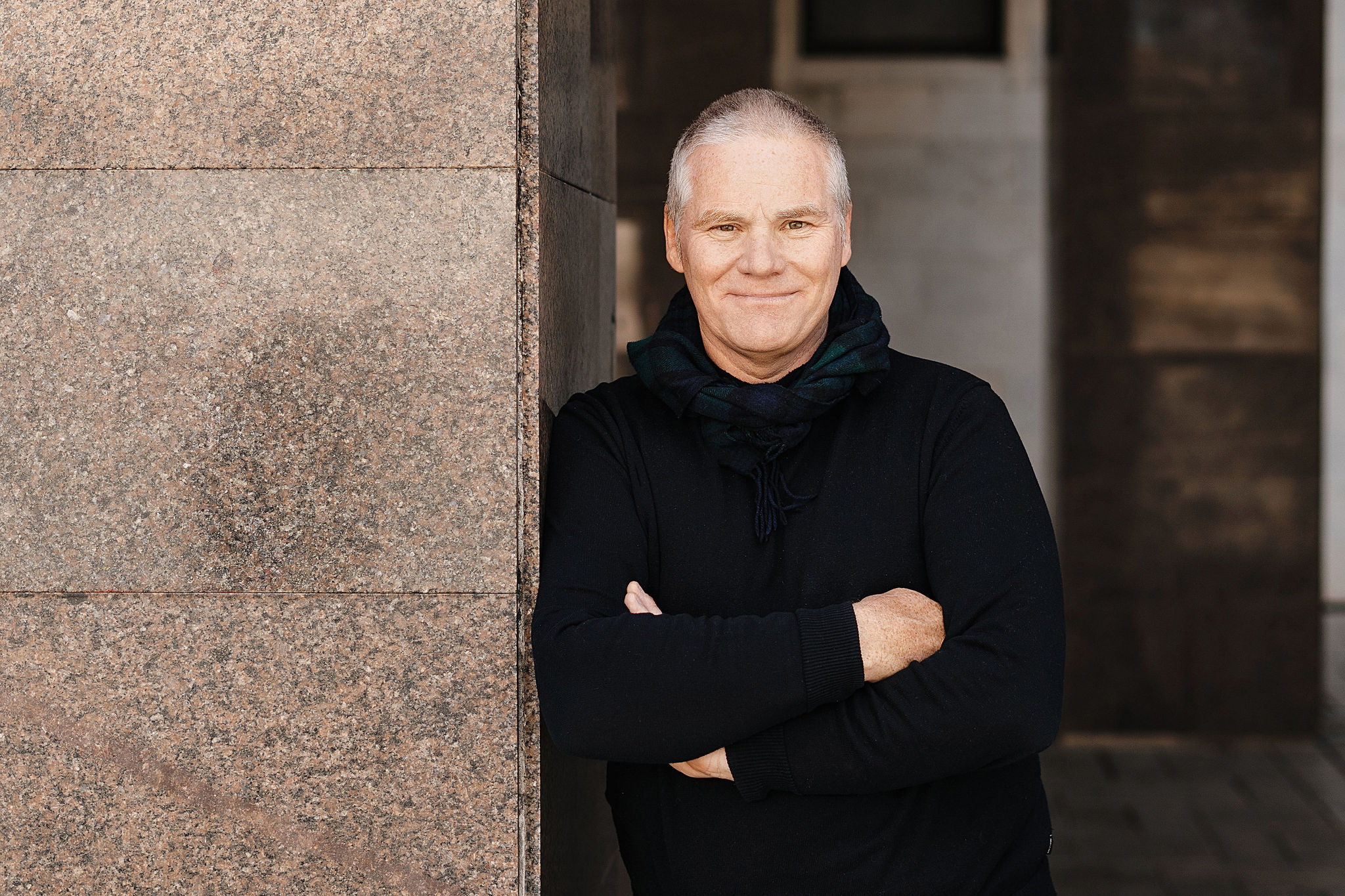 - What are the main (artistic – and not only) challenges while directing events as extensive as opening ceremonies for Olympic games or ECoC? Does the size (budget, too) of creations and ideas liberate you or, on the contrary, put you under an obligation?
- What are the main (artistic – and not only) challenges while directing events as extensive as opening ceremonies for Olympic games or ECoC? Does the size (budget, too) of creations and ideas liberate you or, on the contrary, put you under an obligation?
- Finding the story! Creating a useful and fascinating and helpful myth! Yes! Not all myths are unhelpful. It’s a huge task, a responsibility to be taken seriously, to find the story which interests a wide public, but at the same time does not reinforce stereotypes but creates freedom for us to think and feel about what ‘being together’ means. And that is what drew me to Kaunas in the first place. The team were clear and energised about their aims for Kaunas 2022 – and the fact that a special myth, the Myth of the Kaunas Beast, was to inform our work. Once a story, and a reason for that story, was clear then the big production and artistic decisions, budgetary implications, are so much easier.
We have lived through and continue to be impacted by Covid19. That remains a huge challenge for directing and preparing big events. Involving multiple voices in the building of a story takes lots of rehearsals, lots of listening and conversations. Rehearsals are also predicated on many people and teams coming together to work out solutions and creative proposals. And the events themselves should be carnival-like, for people to have a great time in large groups, sharing liminal moments together. Covid19 has made all three of these things, building story, rehearsals and event design, totally different for the last two years. But not necessarily for the worse! We have had a fantastic year building shows and events. Preparations have depended, more than usual, on technology and the internet. But maybe we have travelled less. Good for our skies! And when we are together it feels so special, so important. It is no surprise to any of us that during the pandemic people turned to culture across the world. Streaming services online and book sales have exploded! We, humans, are all story-telling creatures. That cannot be removed by a pandemic. Rather it is made more necessary. The question remains: Who gets to tell the stories? Are they going to help us understand the nature of the challenges we face? Or do the stories we encounter lead us towards new authoritarian myths and tales which prepare us for a new authoritarian future?
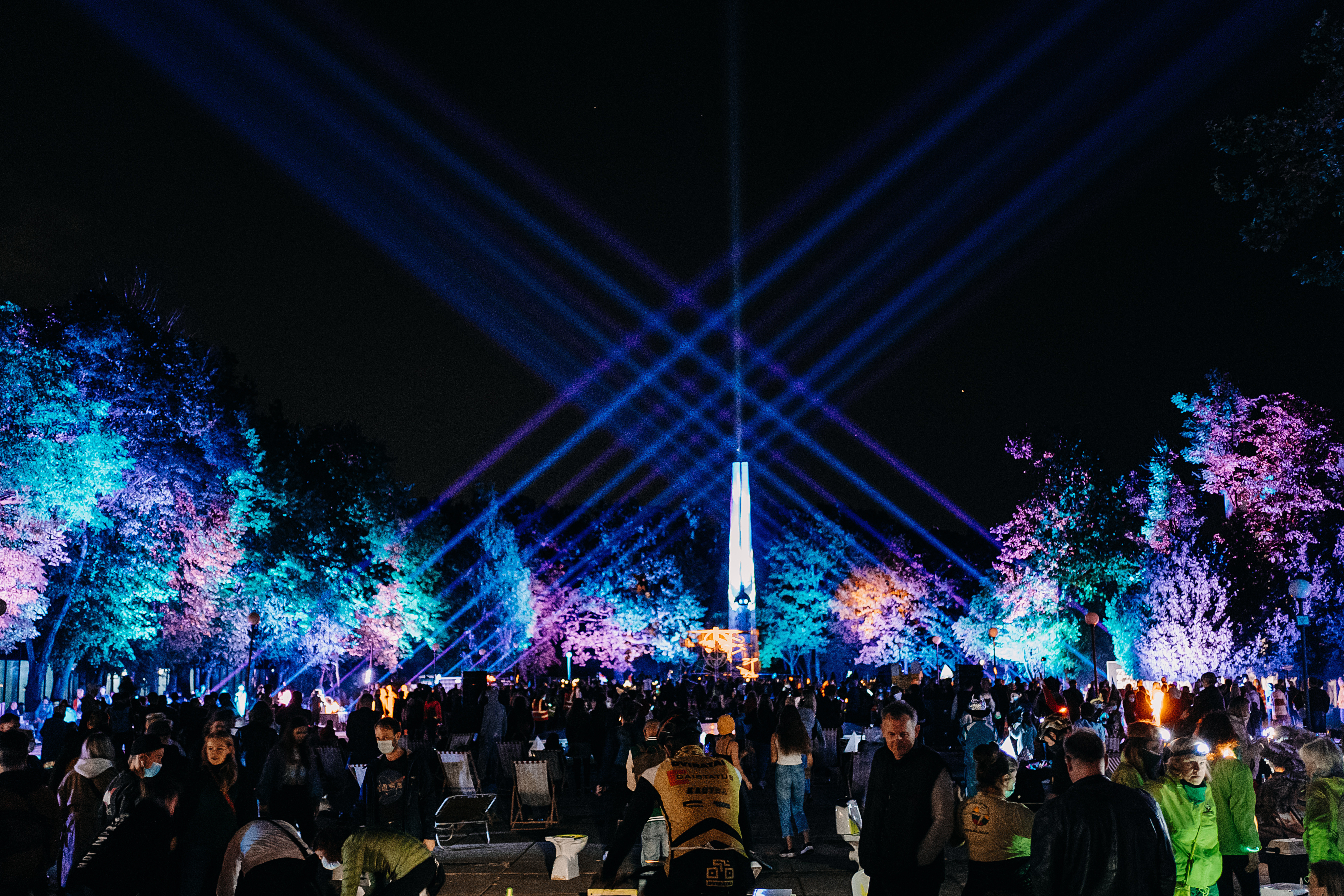 - Could you briefly compare the core ideas – or as you see them – of ECoC Wroclaw, Galway and Kaunas? Can you spot a singular vector for the project of ECoC in general, which is almost 40 years old already? I mean, do European Capitals of Culture have the same role they did in the 1980s or 1990s?
- Could you briefly compare the core ideas – or as you see them – of ECoC Wroclaw, Galway and Kaunas? Can you spot a singular vector for the project of ECoC in general, which is almost 40 years old already? I mean, do European Capitals of Culture have the same role they did in the 1980s or 1990s?
- A place, a city, Kaunas, Galway, Wroclaw are rooted, fixed and identifiable by their geographical locations. The river Corrib is among the shorted river in Europe, and as a result, one of the fastest flowing and most dangerous. The landscapes of western Ireland, Connemara, are harsh and unforgiving yet the purples in the sky and soil leave you staring in disbelief. There is also the legacy of colonialism everywhere. Have these two things impacted Galway’s sense of identity? Intensely. Yet Galway has radically changed demographically in recent decades. And Galway’s ECoC was about the way the past informs the now but also how globalised trade and communications are impacting every aspect of contemporary life. Seas, weather, languages, religions, architecture, design of urban spaces, invasions, colonial legacies all differ from country to country, city to city – yet they are all to be contended with as they are what we all share as Europeans. Wroclaw is also defined by a river, the Odra. It is also defined by legacies of war, language and population removals and arrivals. And Kaunas is defined geographically perhaps by the two great rivers, Nemunas and Neris, with their confluence creating such a magical and defining space. Is Kaunas built in this spot out of coincidence or because of this confluence? That, for me, is what European identity is about – the way we manage the legacy of multiple languages, borders, competing historical myths. As Timothy Snyder, the US historian said last year, “Europe, you are greater than your myths!”. What fascinates me about contemporary ECoC’s, those of the last 10 to 15 years, is that they seem to conclude that diversity in audiences, in communities and artists, multi-linguicism have been, and will remain, ever-present features of European life. Lithuania, Ireland, Poland, Slovenia, Bulgaria, Spain; all EU nations struggling with 20th Century legacies, looking to develop coexistence that helps us manage and thrive in a world where non-border issues now dominate all our lives. We might be from different countries but neither Covid19 nor the climate emergency respects borders, different religions, or languages.
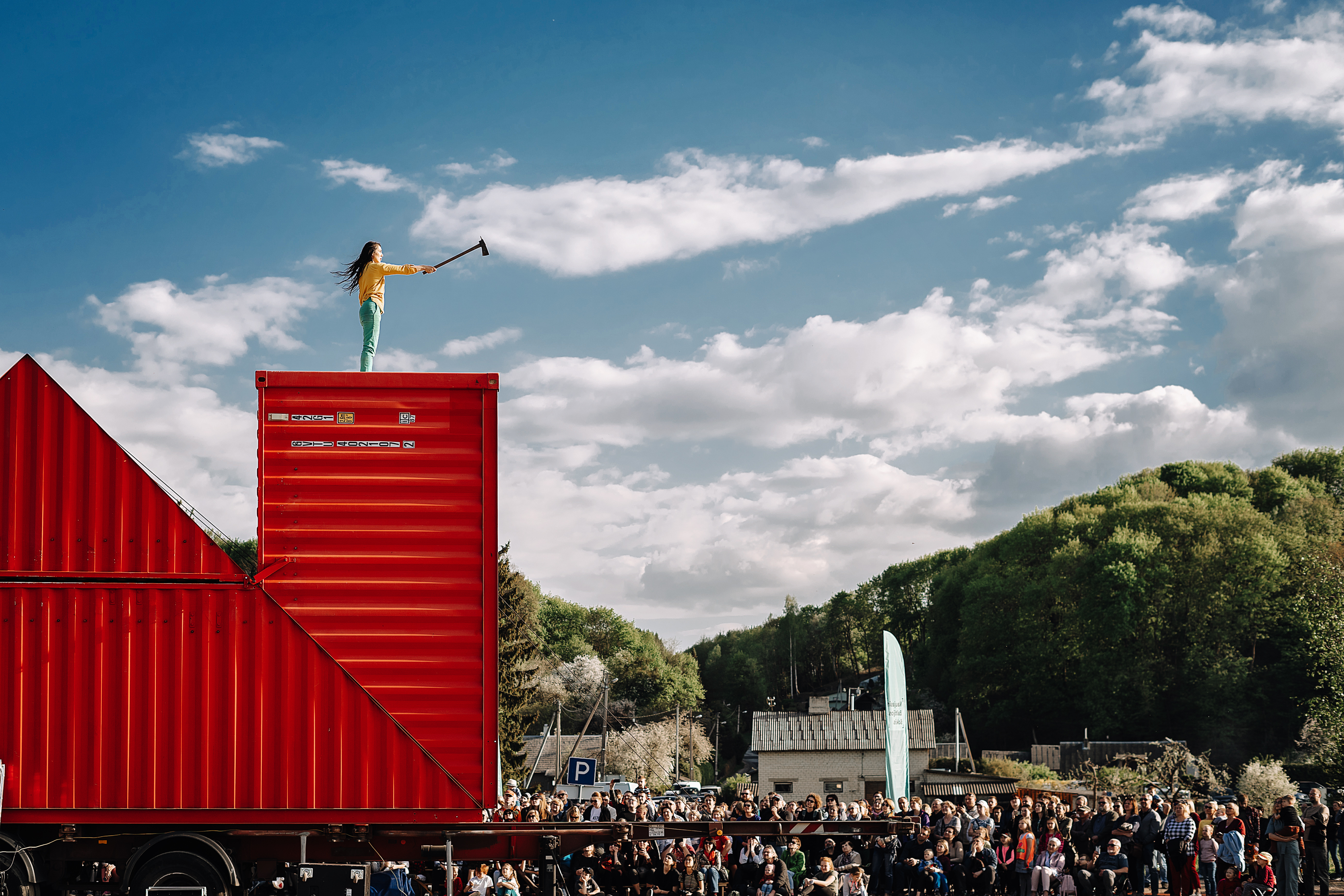 - Are you, as a professional, learning something new while working with Lithuanian artists and communities for the Kaunas 2022 project?
- Are you, as a professional, learning something new while working with Lithuanian artists and communities for the Kaunas 2022 project?
- Kaunas is a keen and great teacher. And I am learning about human struggle, hope and joy from this perspective. On one of my trips to Kaunas, I was picked up by a young taxi driver who, in perfect English, told me about his years in Cork in Ireland. He went on to tell me the story of his family during the late Soviet period and how members of his family had been forced to fight in Afghanistan. He was a very bright and thoughtful young man who had a thousand stories that defined his European-ness. And then there are the extraordinary artists of all generations who are as comfortable working across borders and languages online as they are in referencing early 20th-century Lithuanian poets, painters, and architects. I have learnt about Lithuanian cultural trends, their interconnectedness with history and politics, neighbours, and neighbourhoods. And every day Lithuania and its artists teach me more.
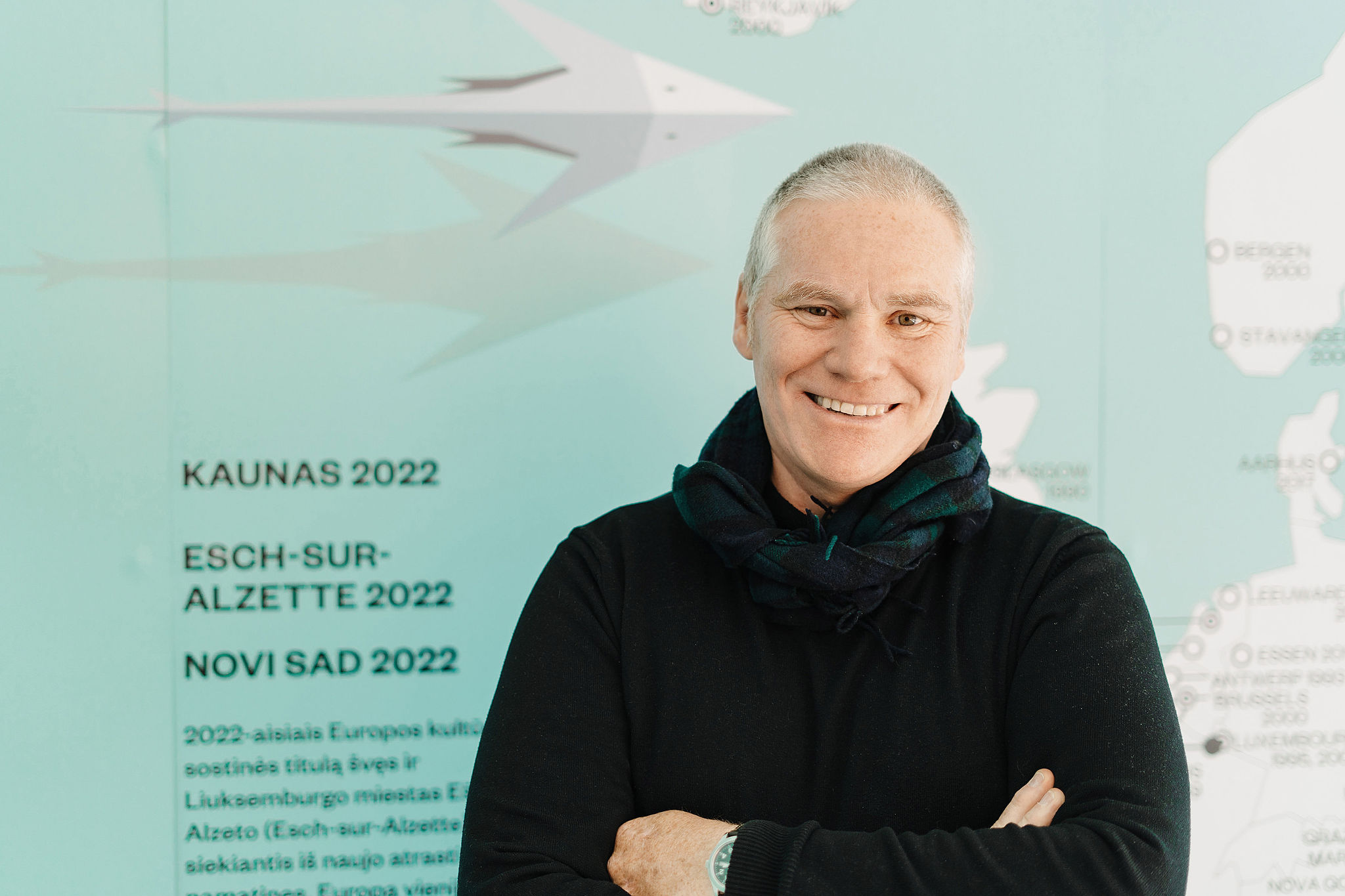 - Would you agree that Kaunas has outgrown itself, its boundaries and stereotypes, during the preparation for 2022? What changes have you noticed while working with the city?
- Would you agree that Kaunas has outgrown itself, its boundaries and stereotypes, during the preparation for 2022? What changes have you noticed while working with the city?
- At the beginning of this conversation, I mentioned that my experience of Spain and Poland led me to see that authoritarianism is not something we accelerate away from but that we need to defend ourselves from – it’s a continual task in which culture, education, civic society and institutions all have a role to play. Kaunas 2022 has made an exceptional contribution to that in my opinion. And it is a key feature about ECoC’s in general, by the way. They are processes, not simply festival events. But just as festival events are defined not just by the acts on stage but by the audience who takes part, an ECoC is as much defined by the way local people, citizens and the wider community interacts with it and accept the invitation it makes to us all! Come and join in! Co-create with us! Make this your ECoC! That is what breaking down a boundary and stereotype means – to actively help in the process of making new meanings, more useful cultural works, which help us understand this world of ours. Kaunas has changed. It’s more fluid, more open, more interconnected within the city and through its understanding of its past. Kaunas is contemporary! It’s a European city with deeply European stories to share. And all this, with more work still to be done, will become the legacy of Kaunas 2022. Legacy is so important as will make sense of the investments, imaginative and financial, that have been made so far. Have you seen how Liverpool 2008 are still talking about their ECoC 22 years later?
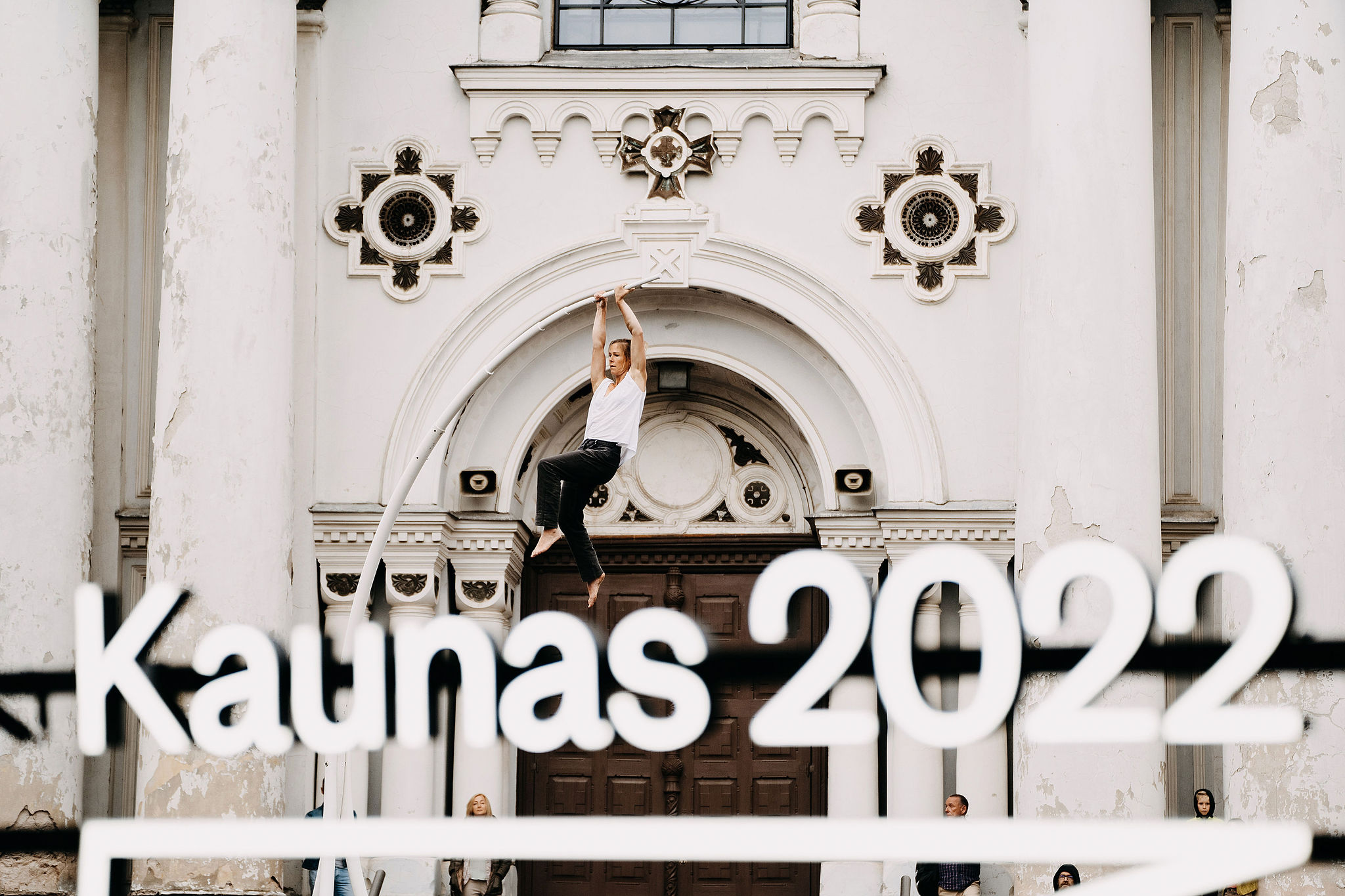 - What is the backbone of the opening event for January? What message do you personally want to stress for the audience?
- What is the backbone of the opening event for January? What message do you personally want to stress for the audience?
- The backbone of the event is a myth! The myth of the Beast of Kaunas. The story will be extended over the other big events we are planning for May 2022 and November 2022. It’s a moment when we can come together, as a city, as a country, and kick the year off through culture. The Beast of Kaunas of course, like all myths, is not real. It’s a beautiful excuse to meet, to reflect and think! The opening weekend is an invitation to everyone. So, the show is the chance to talk together about this city, its past, present and most importantly, its future. And it is the first time in ECoC’s history that three cities, Kaunas, Esch and Novi Sad, will hold the title at the same time. What a chance to extend opportunities for audiences, communities and audiences alike to discover new things about one another?
Next year, Kaunas and Kaunas district will become one big European stage and turn the city to a place where you will not escape culture. More than 40 festivals, 60 exhibitions, 250 performing arts events (of which more than 50 are premieres), and over 250 concerts are planned to take place in 2022. It is going to be the year-long non-stop biggest co-creative festival of all. Come co-create and celebrate with us!
Full programme: https://kaunas2022.eu/en/programme/
The contemporary Myth of Kaunas Trilogy – a journey to a new city identity
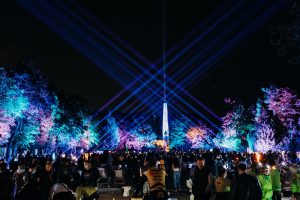
In 2022, Kaunas will be reborn – the myth of the contemporary capital, which the Kaunas – European Capital of Culture 2022 team has been creating for three years, will materialise itself in an impressive programme. The main highlights of the programme are the Myth of Kaunas Trilogy events, which will take place over the three weekends: The Confusion (January 19–23), The Confluence (May 20–22) and The Contract (November 25–27).
For the opening weekend of Kaunas European Capital of Culture, more than 100 events are planned, several hundred professional and non-professional performers will be on the stage. In the impressive opening show, we will see world-famous creators and performers from Lithuania and around the world.
“The Myth of Kaunas Trilogy events, with which we will open the year of Kaunas European Capital of Culture in January, continue in May and close in November is the axis of the programme. We will involve thousands of locals into these events so that they become active participants, characters, extras in crowd scenes, choir performers, and not mere spectators,” says Virginija Vitkienė, the initiator and CEO of Kaunas – European Capital of Culture 2022.
The creative output of the Kaunas – European Capital of Culture 2022 project is being created by 64 organisations, which currently employ almost 300 professionals. About 15 more organisations will join the main events; a total of about 80 partners will implement the European Capital of Culture year program. According to Vitkienė, there will be no free weekend in the year.
“The Myth of Kaunas Trilogy is a journey through the three main events of the European Capital of Culture – a journey much like the three stages of a person’s life: coming to understand who we are, accepting who we are, and coexisting with ourselves – as we are,” says Rytis Zemkauskas, the author of the idea and the script writer for the Trilogy.
The myth of the city, created by all its inhabitants, is united by the metaphor of the Beast. According to Zemkauskas, the Beast is the body of the city, it is as alive as we are. The mythical Kaunas Beast will be awakened in January, we will make better acquaintance with it in May, and will agree to live happily and in harmony at the closing event of the Capital of Culture at the end of November.
The trilogy of Contemporary Kaunas Myth will be told in dozens of books and stories, it will be shaped by exhibitions and performances of Lithuanian and international artists, it will sound in concerts taking place in various places in Kaunas, and will be lit by installations from all over Europe.
Opening of the European Capital of Culture in Kaunas on January 22
Whatever are your plans for the beginning of the next year, arrange your schedule so that you are in Kaunas on January 22. Although the detailed programme of the opening show, which will take place at the Žalgiris Arena at 19.30 pm, is kept secret until the last minute, the organisers reveal that it is being created by hundreds of Kaunas, Lithuanian and international artists.
“The ambitious Kaunas European Capital of Culture programme is based on a unique, sincere, community-involving vision of the Contemporary Capital. The contemporary capital is a city where culture is not just a Sunday theatre but it is a way to act, learn, create innovations, build a community,” says Ana Kočegarova-Maj, Kaunas 2022 Programme Director.
She reminds that thanks to all the creators of the programme, Kaunas will host exhibitions of the world’s most famous artists, such as Marina Abramović, Yoko Ono or William Kentridge, will invite its citizens and city guests to the festivals of a unique scale and artistic quality.

At the opening event of Kaunas – the European Capital of Culture 2022, a synthesis of contemporary music, giant video projections and slam poetry will tell the story of the city as a living miracle, which constantly renews itself. The goal of the programme is to involve everyone in the city’s creative uprising. Kaunas invites the audience around the word to watch the opening broadcast live.
The opening event is being created by British director Chris Baldwin, who has contributed to the key events of the European Capitals of Culture in Wroclaw (Poland), Galway (Ireland) and London Olympics. The music for the event is composed by the Golden Cross of the Stage multiple awardee Antanas Jasenka. The music will be performed by the National Symphony Orchestra and Vilnius Choir, conducted by Modestas Pitrėnas, the winner of the Lithuanian National Culture and Art Prize.
A team of several producers coordinates an impressive opening show, where the Aura Dance Theatre, the authors of experiential video installations OKTA Studio and the masters of world-famous installations and performances, whose names are not yet revealed by the organisers, will provide an unforgettable experience to the city’s residents, guests and the spectators around the world. The costumes of the event are created by Aleksandra Jacovskytė, Julija Skuratova, Sandra Straukaitė.
100 events over the weekend
There are more than 100 events scheduled for The Confusion weekend, which will start on the outskirts of Kaunas on January 19, and will move towards the city centre, congesting residents for the opening. It is estimated that several hundred professional and non-professional performers will appear on stage over the weekend.

On the eve of the opening, January 21 the most important 2022 visual arts exhibitions will open. William Kentrige’s solo exhibition What We Don’t Remember at the M.K. Čiurlionis Museum will introduce the works of this world-famous South African artist of Lithuanian-Jewish heritage to Kaunas residents and the city guests. Also, on that weekend, the four-month exhibition Modernism for the Future 360/365 dedicated to the architecture of Kaunas and European modernism will open at Kaunas Central Post Office. The exhibition will feature projects from 17 artists created during the art residencies over the last year. In addition, the exhibitions of artists from the Capitals of Culture 2022, Esch-sur-Alzette (Luxembourg) and Novi Sad (Serbia), will open.
The opening of the installation “Exit it” by the peace activist multimedia artist Yoko Ono is also scheduled for January 22. The installation will run until September 2022.

Dozens of cultural institutions of Kaunas and Kaunas district are creating a special programme for the first Myth of Kaunas Trilogy weekend. The Confusion programme includes concerts, dance performances and plays, excursions and creative workshops. According to the organisers, one will not be able to escape culture.
The mythical beast of Kaunas will budge in his sleep and… wake up.
Kaunas birthday will be celebrated next to rivers
Kaunas is located in an exceptional place, at the confluence of two major Lithuanian rivers – the Nemunas and the Neris. In addition, in Kaunas, on the way to Raudondvaris, another confluence – of the Nemunas and the Nevėžis – is located, surrounded by a beautiful natural park. Although riverfront in a town usually serves as a natural attraction, Kaunas residents have only relatively recently discovered these beautiful spots and started to spend their free time there.
The Confluence event, which will take place on May 20–22, will fulfil the dream of Kaunas people to return to the rivers and to immerse into the flow of creativity. Saturday evening event will be held in one of the most beautiful places in Lithuania – the Nemunas and Neris confluence. The event will end with a show on water of an unprecedented scale in Lithuania, directed by Chris Baldwin.
Kaunas birthday weekend was chosen for the Confluence, the second part in the Myth of Contemporary Kaunas Trilogy. Moreover, on the same date, the largest international kite festival “Between Earth and Sky” is taking place in Kaunas district. For three days, Kaunas residents and guests will be entertained by performances of acrobats, modern circus, musical picnics in the Kaunas district settlements located by the rivers – the action will take place on the shores, in the water and in the sky. If conditions allow, we will receive guests from other European Capitals of Culture and Alytus, which will be the Lithuanian Capital of Culture in 2022.
People say that in this weekend we will definitely see the beast of Kaunas ...
Closing event: contemporary opera in Raudondvaris Manor
The official closing of Kaunas – European Capital of Culture 2022 will take place on the last weekend of November, on 25–27. According to the organisers, the Contract part of the Trilogy is dedicated to making agreement with the city, to pledge to live together in harmony.
“When we started preparing the application for the project several years ago, we “diagnosed” Kaunas as grey, very complex, we saw it as a teenager who is not loved and does not love himself. Today, inviting people to the European Capital of Culture 2022 events, we look forward to welcoming visitors in an already changed, more hospitable, more sociable, more youthful, more stylish, more empathetic, more sustainable city, open to their own and European history and present. Kaunas is no longer afraid of the ghosts of the past and does not have complexes due to real or imaginary insignificance. We are looking forward to welcoming you in a European city of happy people”, says Vitkienė.
The central event of the Contract weekend is created by the Lithuanian National Prize winner composer Zita Bružaitė, director Gediminas Šeduikis, the playwright Daiva Čepauskaitė, the winner of the Golden Stage Cross. Together with hundreds of the most talented Lithuanian performers, the contemporary opera will consolidate the agreement of Kaunas residents with their city, will sound the promise of living long and happily. An impressive audiovisual show, which will close the year of the European Capital of Culture in Kaunas, will take place at Raudondvaris Manor on Sunday evening.
A special exhibition commemorating 2022 will also be opened in Raudondvaris, and on the closing weekend Kaunas will be adorned with modern light installations from other European cities and other European capitals. Although then Kaunas will officially pass over the title of European Capital of Culture to other cities, it will forever remain a city of contemporary culture.
Kaunas Beast, actively involved in the process of creating a contemporary urban myth, will remain in the city and watch over the contract signed by the residents of the city.
Kaunas as an International Meeting Point: The Star-studded Program of the European Capital of Culture
The international ties between Kaunas and the world intensified right after announcing the city would become the European Capital of Culture in 2022. No wonder it will be the year of numerous dream-come-true moments for art producers, directors and cultural operators – as well as the year of discovering Kaunas, the contemporary capital, for quality-seeking culture lovers from all over the continent and beyond.
Even though the programme of Kaunas 2022 is prepared by thousands of local artists and residents and is firstly and foremostly dedicated to them, it’s the globally renowned names that create and emphasise the value of the ambitious long-running project.
For some of the world’s finest artists, the title of European Capital of Culture will become the reason to visit the homeland of their ancestors. The visits of others will become the final touch of years of collaborations and partnerships. One thing is for sure – everyone will want to be in Kaunas, the epicentre of European culture, in 2022. Everyone from the international theatre superstar Robert Wilson to the performance art prodigy Marina Abramović.
To Heal From What we do not Remember
By far, the best-known contemporary art name in the exhibition map of Kaunas 2022 is William Kentridge (b. 1955, SA), whose work will, for the first time in history, be shown in Kaunas, the place where the roots of his family are. The artist, an honest and painfully candid humanist whose exhibitions are demanded by the best galleries in the world, grew up in Johannesburg, a city full of contrasts between stunning nature and industrial landscape. His works are saturated with difficult topics, including human rights, racial and financial inequality, revolutions and inconvenient tête-à-têtes between upstanding ideas and shameful everyday life.
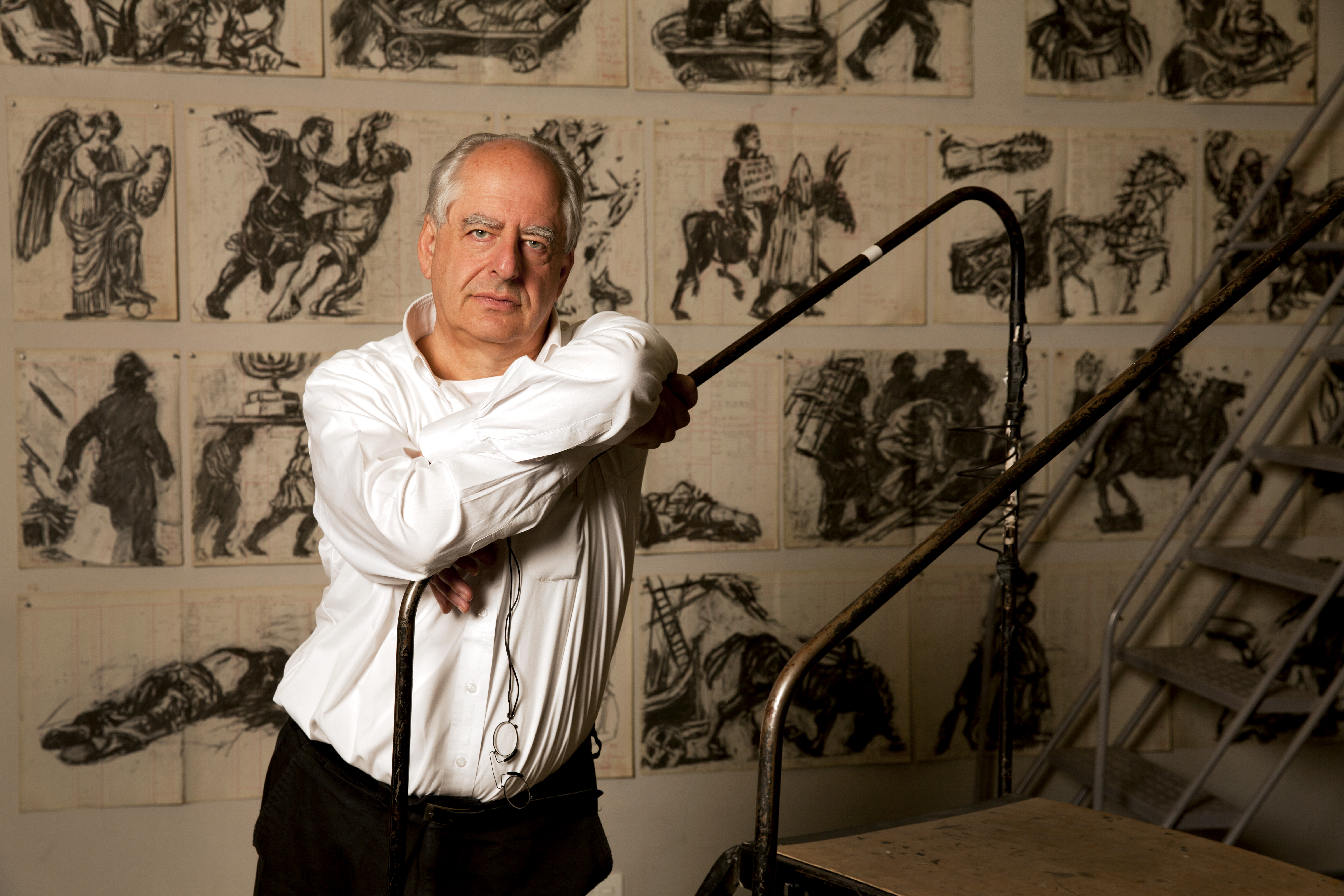
The curator of the exhibition That Which We Do Not Remember at the M. K. Čiurlionis National Museum is Virginija Vitkienė, head of Kaunas 2022. She recalls that back in 2016, when she first started inviting Kentridge to Kaunas, she knew well that he had a moral right to refuse to come to a country from which his grandfathers and great-grandfathers fled in the 19th century – and this helped them to avoid the tragic events of the WW2. ‘I hoped him agreeing to participate would help the much-needed process of reclaiming our memory and helping us to heal from what we do not remember,’ V. Vitkienė says, adding that the artist accepted the invitation with his signature energy. Together with his signature pieces, such as Refusal of Time, Drawing Lessons and Drawings for Projections, Kentridge created a series of bird drawings especially for Kaunas and an installation You Who Never Arrived in the auditorium of the museum.
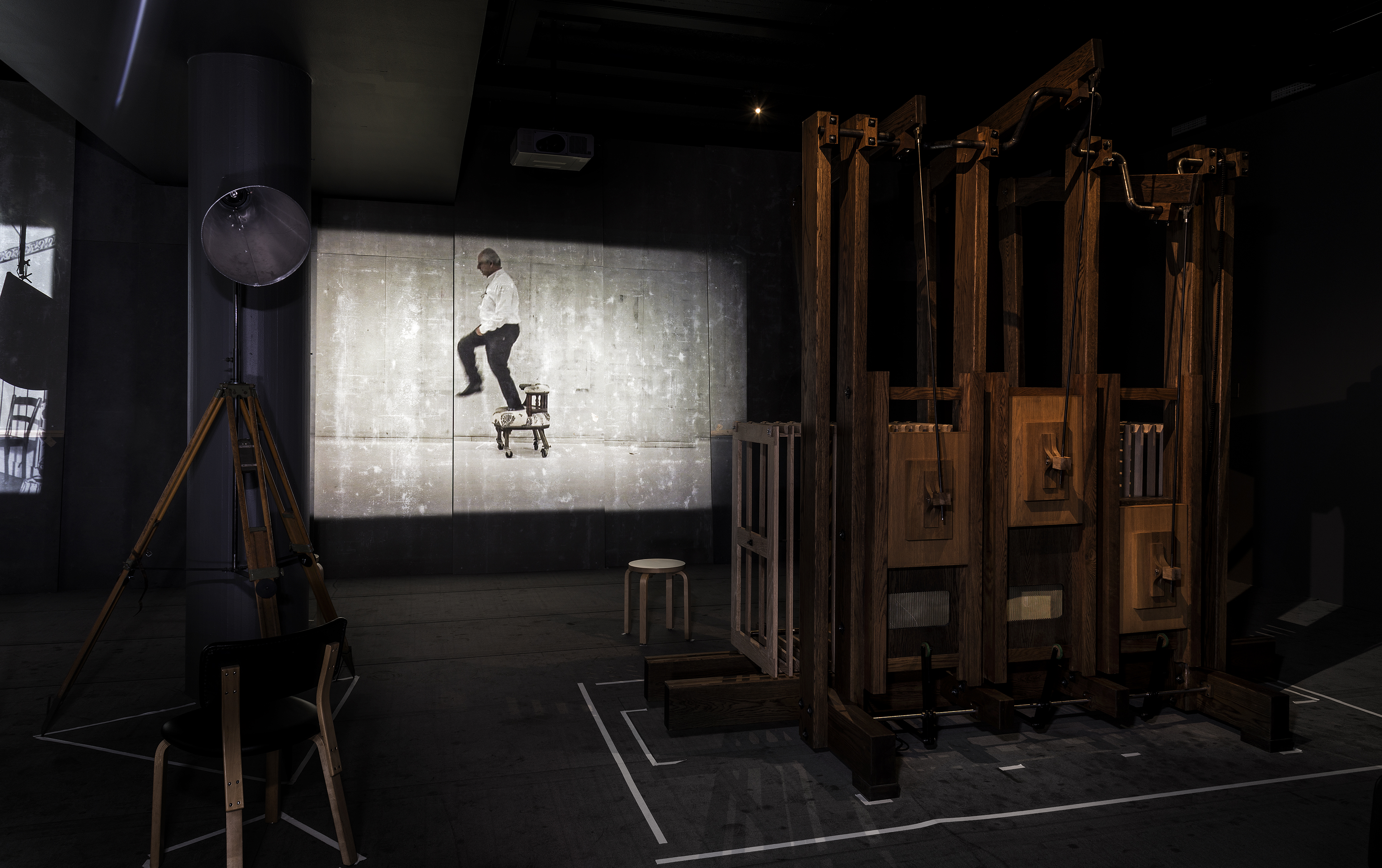
‘I wish the spectators experience the exhibition as a conscious effort to remember as if it was the only honest way to live and coexist. I invite everyone to reflect both global and personal memory gaps with the artist,’ says the curator. The exhibition That Which We Do Not Remember will run from January 22 to November 30.
International Winds of Theatre
“National Kaunas Drama Theatre is one of the greatest partners of Kaunas 2022, carrying a huge load of our programme and organising truly impressive premieres with the most famous European and Lithuanian directors. This perfectly illustrates the fact that Kaunas is becoming one big European stage,” noted the head of Kaunas 2022 programme Ana Kočegarova–Maj at the end of the summer during the launch of the 102nd season of the theatre. She did not exaggerate, as the solid, long-matured creative collaborations with artists from Germany, Canada, Hungary, Norway, Luxembourg, the United States, Georgia, and Latvia will finally become eight impressive premieres digging into universal topics.
One of the most significant events in the history of Lithuania’s oldest theatre and one of the biggest mysteries so far is Dorian, a performance directed by the American theatre magician Robert Wilson. He has already cast two Lithuanian actors for what was supposed to be a solo performance. Dorian’s premiere will take place in Autumn 2022.
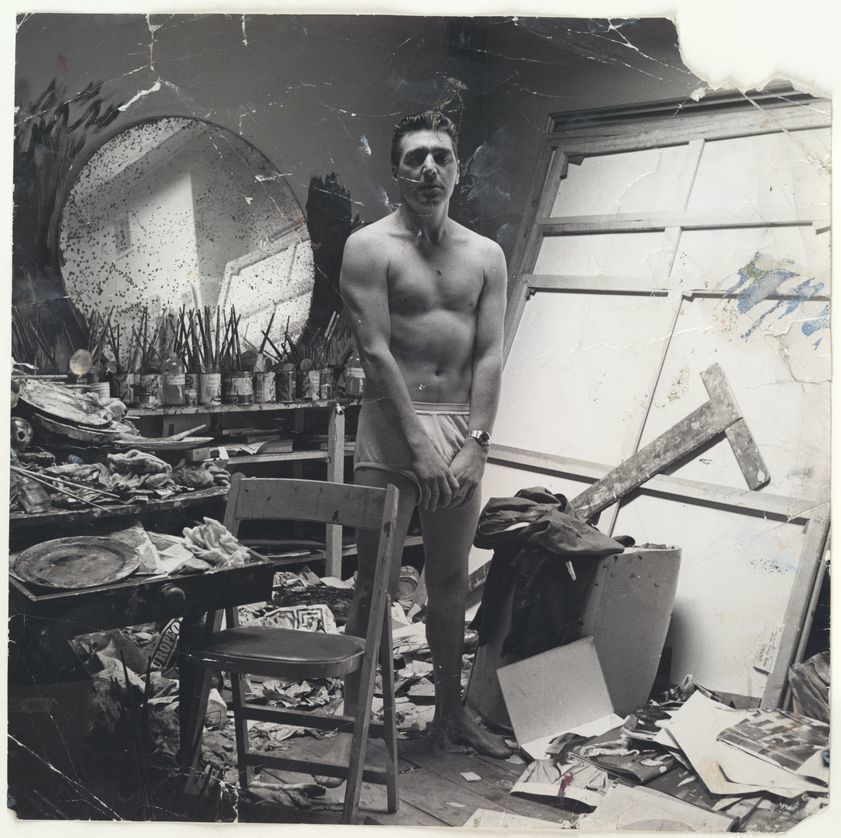
Finally, in Kaunas!
‘Finally’ was most definitely the first word spoken by the team of Meno Parkas gallery after finally securing the most ambitious event in its history, as well as the term used to illustrate the expression by the spectators of Kaunas 2022 program announcement.
2022 will present a unique opportunity to see Memory of Being, a solo exhibition by Marina Abramović, one of the world’s most renowned artists. This and the artist’s visit on April 1 will be one of the programme’s most significant events.
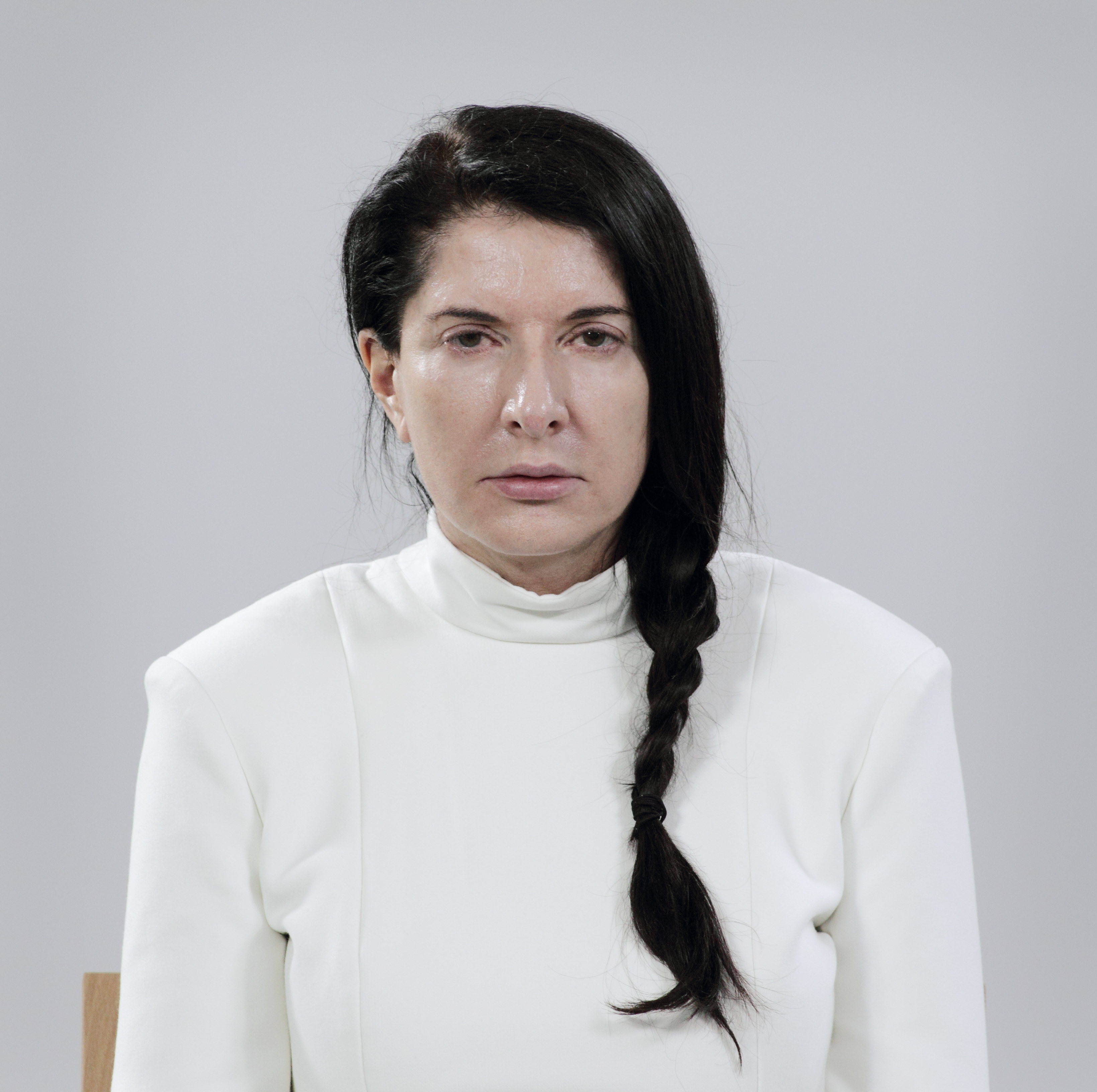
The exhibition is based on Abramović’s series The Cleaner, which began at the Moderna Museet in Stockholm in 2017. The show provides a detailed presentation of the essential stages of Marina's work since the 1960s. It will feature video documentations of her interviews and most famous works, as well as the artist’s best-known video installations.
This impressive project was made possible through the partnership of Meno Parkas with the Centre for Contemporary Art Znaki Czasu in Toruń, the Marina Abramović Institute, the Museum of Contemporary Art in Belgrade and the Moderna Museet in Stockholm.
It’s pretty symbolic that the art of Yoko Ono will be visiting Kaunas, the native city of her friend George Maciunas. The Learning Garden of Freedom is a retrospective exhibition of the nonconformist artist’s work and is the result of a collaboration between the artist’s Studio One in New York and the Kaunas Picture Gallery located not far from George Maciunas’ childhood home. The exhibition in Kaunas is presented by Contemporary Art Centre (curator: Jonas Hendricks (US)).In Autumn 2022, the exhibition will feature numerous works by Yoko Ono spanning different creative periods and practices: from conceptual art and experimental film to spatial installations, objects, word pieces, and performance art.
Also, the famous installation Exit It by Yoko Ono will be exhibited in the building of the Bank of Lithuania from January to September.
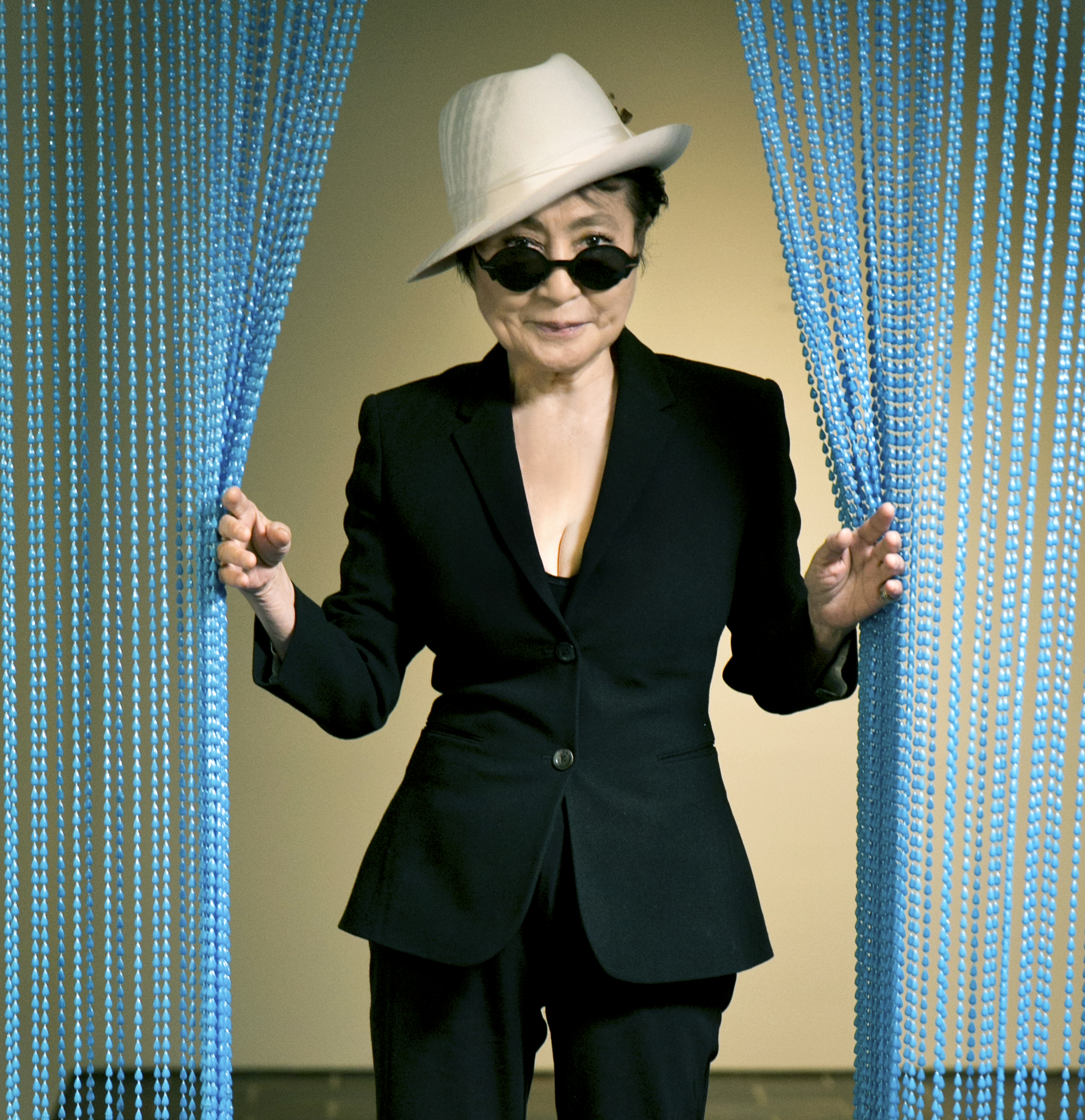
Global Music Programme With Lithuanian Touches
The title of Kaunas 2022 has proved to be a great tool to invite the globally renowned Lithuanian artists to come back to their homeland with exceptional performances.
Mirga Gražinytė-Tyla, often recognised as the best female conductor in the world and leader of the finest orchestras around the globe, is one of such names. On September 2, Gražinytė-Tyla will conduct the Lithuanian National Symphony Orchestra, the Kaunas State Choir, Katowice City Vocal Ensemble and Aidija Chamber Choir at the Pažaislis Monastery, considered a Baroque pearl. In addition to Maurice Ravel’s Piano Concerto in G major, the concert will culminate in a truly singular event: the world premiere performance of the Ninth Symphony by Mieczysław Weinberg, one of Poland’s most intriguing 20th-century composers.
On October 9, an exclusive concert by the Royal Philharmonic Orchestra (Great Britain) will be held at the historic Kaunas Sports Hall. Together with the Kaunas State Choir, the orchestra will perform Ludwig van Beethoven’s Choral Fantasy, Op. 80, the predecessor to the famous Ode to Joy, the anthem of the European Union, presenting audiences with the gift of joyful emotion.
There’s more! On October 30, Requiem, the Grammy-winning composition by one of the world’s most famous contemporary composers, Andrew Lloyd Webber, will be performed for the first time in Lithuania — of course, the event will be held at the region’s biggest Žalgirio arena.
The work will be presented by the Kaunas City Symphony Orchestra and an array of world-famous performers and soloists, including the Kaunas State Choir, the Dagilėlis Boys and the Youth Choir, soprano Lina Dambrauskaitė, tenor Edgaras Montvidas, and conducted by Constantine Orbelian.
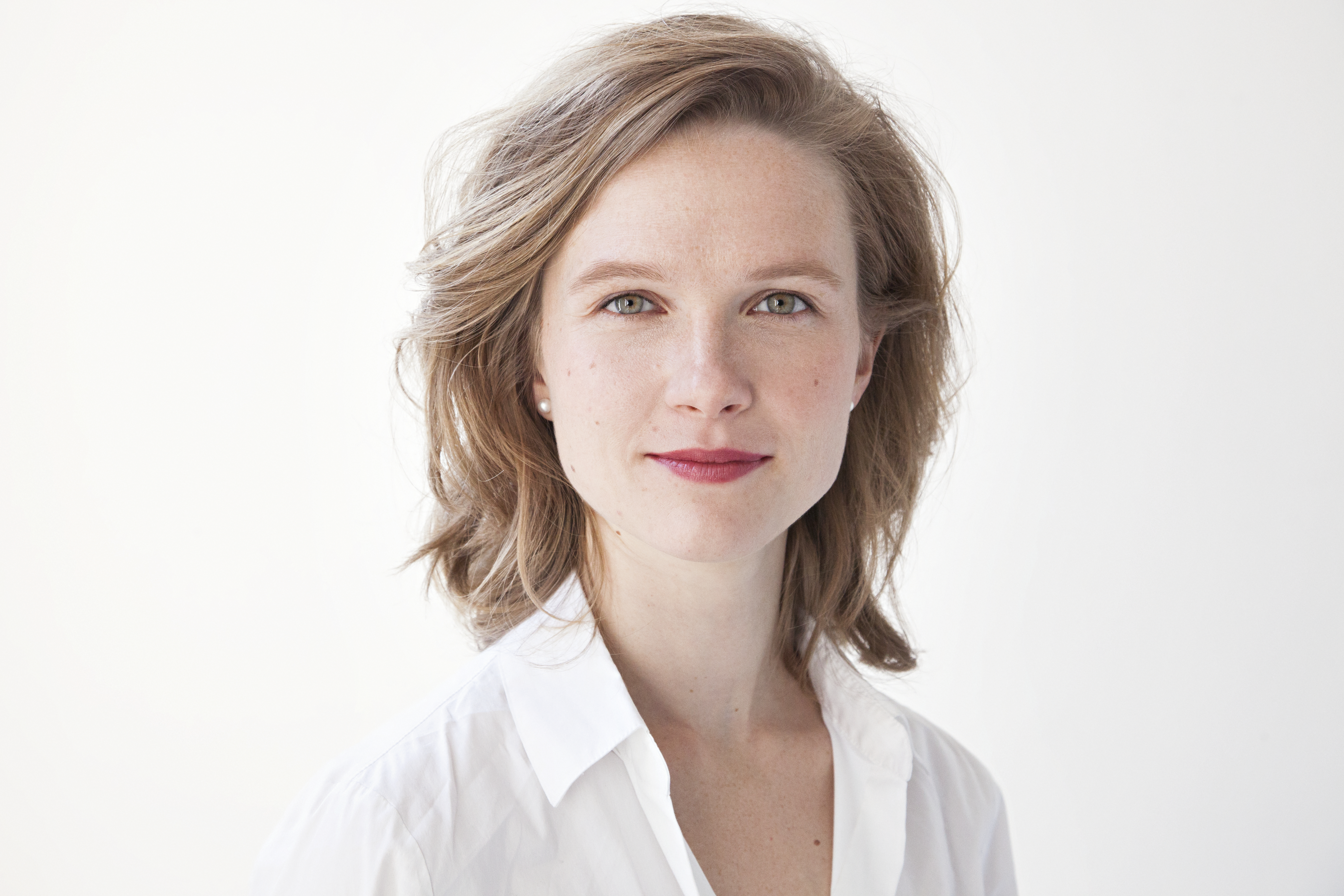
Coming Home
Memory Office, one of the critical branches of the Kaunas 2022 programme, is focused on rediscovering the multicultural face of Kaunas. In 2022, it will reach its peak at the World Litvak Forum, where Litvaks scattered throughout the world to return, even if only briefly, to their ancestral land and gather together. Over several days, this event will feature a rich cultural programme and discussions with renowned artists, academics, and representatives of the artistic world.
The final touch of the forum will be the premiere of Kaunas Cantata, specially composed by Philip Miller (South Africa), an artist with roots in Lithuania. He collaborates with artist Jenny Kagan (Great Britain), whose parents once fell in love in the Kaunas Ghetto, and local musicians. The work is an inclusive musical experience, calling listeners to immerse themselves in the city’s past. Kagan will also present a solo exhibition in Kaunas, focusing on her family’s history.
It’s important to stress that each branch of Kaunas 2022 has its own superstars, some of whom are still on their way to international fame – and, what is even more significant is Kaunas and Kaunas District as one big European stage, will most definitely become their trampoline.
In 2022, culture will be inescapable. From cosy rendezvous under verdant trees to massive spine-tingling events, from installations to world-class performances, from theatrical tours to design workshops. Kaunas 2022 encompasses over 1000 events! More than 40 festivals, 60 exhibitions, 250 performing arts events (of which more than 50 are premieres), and over 250 concerts are planned to take place in 2022. All this is delivered by Kaunas 2022’s team of 500 people, alongside 80 local and 150 foreign partners. 141 cities in Lithuania and the world, 2,000 artists, 80 communities, and 1,000 great volunteers.
Kaunas European Capital of Culture 2022 Youth Programme: Get ready to be taken out of your comfort zone
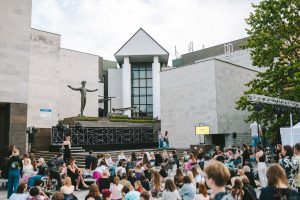
The city is its people. What will Kaunas look like in twenty or fifty years? The answer to this question can be found by talking, listening and simply spending time with young people. After hearing, seeing and feeling what they care about, we can predict how future Kaunas residents will live and what they will care about. The events of the Emerging Kaunas in the year of the European Capital of Culture will allow to peek through a keyhole into the future of Kaunas.
“Emerging Kaunas is a programme for young people by young people. The central office of the European Capital of Culture even allocated a separate TEMPO space for us, where we can feel free and be ourselves, and talk about what concerns us in the language we understand best,” says Aurelija Prašmuntaitė, the Curator of the programme.
According to her, encouraging young people to participate in culture can only be done by providing them the opportunity to take the initiative themselves. Young people in Kaunas co-create quality cultural products in cooperation with Kaunas Chamber Theatre, Pažaislis Music Festival, Gamers Dance Studio and other partners. The Emerging Kaunas programme has several creative platforms, including the Kaunas Challenge and the More Tempo initiatives, which cultural community is constantly growing.
In 2022, the Emerging Kaunas programme in the European Capital of Culture year will explode with emotions, glow with impressions, it will tickle the senses and arouse curiosity.
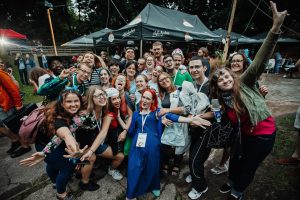
Audra Contemporary City Festival – the central event of the youth programme
The central event of the youth programme is the Audra Contemporary City Festival, which will take place from June 29 to July 3, 2022. Contemporary art installations will emerge in various parts of the city, accompanied by concerts by different performers. Electronic, experimental, acoustic music will be performed at Kaunas Philharmonic, Mykolas Žilinskas Art Gallery, Kaunas Taxi Park, Pergalė Concert, Kaunas Confluence and other places.
The Festival team was joined by the Freimas International Association of Artists, which together with the team of the Lizdas night club creates the musical program for the Festival. The organisers assure all the lovers of quality electronic music: you can relax and wait for this unique event, which will shake Kaunas from the ground up and allow you to peek into its future.
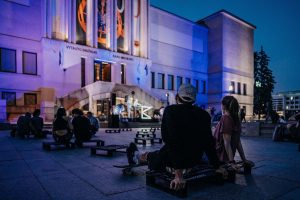
Audra Contemporary City Festival is an event that reflects the lifestyle and values of the young people. This is a city festival that invites to discover the identity of Kaunas, of youth communities together with your personal identity. Audra summons curious people to enjoy the experience and bold discussions. There will be no participants in this festival – everyone will be its creator. The ideological leaders, guides and implementers of this festival are the participants of the Kaunas – European Capital of Culture 2022 youth programme Emerging Kaunas.
There will be more action involving young people in the city on the same days. The Gamers City Battle 2022 street dance event will bring together participants of various street dance subcultures and nationalities from all over Europe. One of celebrities of the event is the French legend Salah, who will take his place in the judge’s chair. Hundreds of colourful and inventive dancers’ costumes, quality music, street dancers’ choreography – this is something definitely worth looking forward to.
Among the most prominent partners will be Inconvenient Films, which will invite the audience to explore the topics of psychological health and identity. Interestingly, these partners will bring the content of the audio documentaries, which will be designed with subtitle projections on Kaunas city buildings.
Also, we welcome the Diversion Cinema programme from our French partners. They will offer a unique virtual reality experience. During the festival, participants will be able to explore virtual reality not only through the possibilities of a stationary VR film, but while walking around space. We plan to bring a unique performance that combines VR and contemporary dance.
Audience is also invited to the premiere of the socio-political theatre – performances of the EYE NET 2.0 project about the experiences of young people will be shown, and creators from 7 European countries will come to Kaunas. The Lithuanian performance is directed by Rokas Lažaunykas, and the Mr. Stagey theatre troupe is participating. The Emerging Kaunas team is creating a performance with its partner Pažaislis Music Festival.
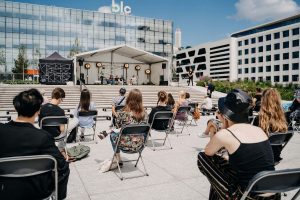
Tempo space for young people is teeming with life
The above-mentioned events are the result of the young people’s co-creation with the partners of the Emerging Kaunas programme. In 2022, we will see more of these.
The Kaunas Chamber Theatre Young Performing Arts Training Programme “Prodiusai Colab”, which aims to create conditions for young people to learn from performing arts professionals by implementing co-productions with foreign and Lithuanian artists, will stage two premieres for the 2022 programme. The sketch of “Jeanne”, the script of which is based on the archives from the court of Jeanne D'Arc and which is based on the principle of collaborative theatre, was shown already this year. At the beginning of the next year, we will see “Dance That Didn’t Exist” – a performance based on contact improvisation with the audience. Dancers’ duets, mass scenes, synchronization, change of rhythms will shatter the established opinion about dance.
“We’re creating something that’s never existed in Kaunas before, and we hope that the result of our work will help as many young people as possible to stay in both Kaunas and the Kaunas District, with which we’re also working quite a bit,” says Prašmuntaitė.
Indeed, the unique Tempo Space of Kaunas – European Capital of Culture 2022 dedicated for young people is teeming with life. The initiative More Tempo invites using the spaces to present personal initiatives, be it performances, exhibitions, installations, or other projects. Moreover, every September, young people are invited to join the Kaunas Challenge where they get the opportunity to implement their ideas for the city and the Kaunas district together with the Kaunas 2022 team. The graduates of the Kaunas Challenge programme can continue their activities in the alumni club, where they can learn from their experience and experiment with the implementation of their cultural ideas.
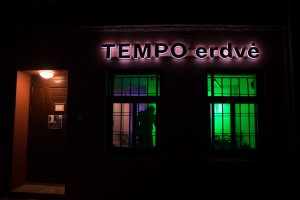
Cultural co-creation is a continuous process
The initiative inviting young people to join the Kaunas Challenge has already grown its alumni community. The projects developed by these young active people not only enrich the cultural life of the city, but also gradually change the cultural spaces of Kaunas, bringing new ideas, telling the stories from the young people’s perspective.
Among the initiatives born in this community are: PUOTA (Eng. feast), an audio-visual project that integrates the poetry created by the citizens into public spaces, MASS magazine, created by cultural youth and dedicated to such a reader, RANDAI (Eng. scars), a project that allows people to share their emotional experiences through photographs and personal texts, KOMODA (Eng. chest of drawers), which provides a platform for young fashion designers in Kaunas to organise their exhibitions, fashion shows, and performances in urban spaces, PUSĖS DAINOS FESTIVALIS (PDF) (Eng. half-song festival), an event that allows trap/rap music writers to perform their song to the public.
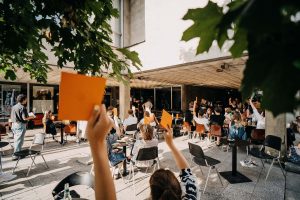
Through their projects, young people not only promote creative self-expression and the cultural life of Kaunas, but they also undertake education and look for the ways to spend quality leisure time. For instance, the video content created by SERIJA-F team is dedicated to financial literacy issues, ŽAIDŽIAM KAUNĄ (Eng. let’s play Kaunas) encourages to skip virtual games and join the board game community. During the project, a game about Kaunas was created, where cultural symbols relevant to the city are woven into the narrative of the game. MINDFAQ evenings invite to the play detective games.
“The content that is attractive, which addresses the challenges of access to culture for young people is created. The members of the Kaunas Challenge Alumni Club work independently in consultation with Kaunas 2022 mentors,” explains the curator of the Emerging Kaunas programme.
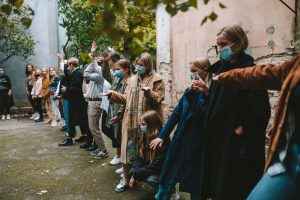
Focus on the youngest citizens
Capital of Culture Classes are another essential part of the 2022 cultural programme curated by Emerging Kaunas. Among the classes already planned are an animation weekend at the Romuva Cinema Centre, an educational theatre club, two youth theatre festivals, a children’s book festival and other events. However, the programme can still be expanded – Kaunas and Kaunas district schools and kindergartens, other educational institutions are invited to join in creating educational projects.
From April 29 to May 1, Kaunas Maironis Literature Museum will invite to the Live Letters Children’s Book festival, where the little ones will be able to meet writers and book characters, find Kaunas hidden in fairy tales, and see the Mythical Beast of Kaunas. Live Letters is a Part of Kaunas Literature Week, organised by Vytautas Magnus University, intended for the youngest readers. By the way, since we are on the subject of literature – in 2022, the book “Tales of Kaunas Nations” will be published, in original and Lithuanian languages, by Terra Publica. The colourful illustrations and QR codes that will allow unique stories to be heard will complement the texts.
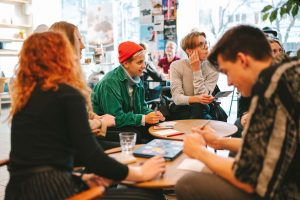
Probably not everyone knows that in the first half of the 20th century, world-famous animation and cinema artist Vladislovas Starevičius lived and worked in Kaunas. Remembering this creator, the animation laboratory will be open at the Romuva Cinema Centre on May 21–22, where students will be able to get acquainted with the history and practice of animation. At the same time, the Animation Weekend will offer a programme of the most relevant and latest animated films for children and adults.
On June 12, the Pažaislis Music Festival will invite you to a truly extraordinary event in Raudondvaris to see the children’s opera “Kirana”. For five days, three professional performers from Malta will lead a creative workshop for children, and what the children will create – will also be shown on stage. The scenography will use the works of Kaunas Antanas Martinaitis Art School students, the children will contribute to the soundtrack, they will improvise and learn performing arts. The history of the “Kirana” opera was inspired by the myths of China, India, Babylon and Mesopotamia. In each country where the opera is staged, it is enriched with the work of local talent.
From theatre festivals to ecological citizenship education
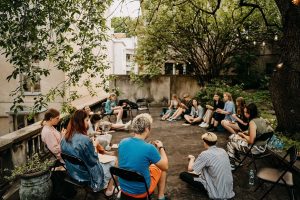
In the Capital of Culture Classes programme, a lot of attention was paid to the theatre art. Kaunas National Drama Theatre will offer many events and educational programs for children and youth. Among them is an interactive performance for young people “The Tower of Babel”, the premiere of which will take place in Kaunas and Kaunas district – Čekiškė – on August 19–23; the director of the performance, Norwegian Hilde Brinchmann, uses both her own experience and that of each partner. The International Educational Theatre Festival for Children and Youth “Dive into the Theatre” on June 1–4 will invite young people to look behind the scenes, to get to know the actors. In addition, the Educational Theatre Club will offer a series of events inviting to use the possibilities of theatre art while learning the current subjects of the school programme.
In September 2022, Kaunas Chamber Drama Theatre will organise the Youth Theatre Festival “The Starting Point”, where beginning performers will present their current issues, social ideas and attitudes, emphasising theatre art as an important form of youth communication. The festival is aimed at people who are not indifferent to the most pressing issues and dilemmas of the contemporary society related to climate change, human and animal rights, politics.
The educational programme “Point of Change” for the development of ecological citizenship of students, which will take place in educational institutions of Kaunas and Kaunas region, will encourage action and create a space for new experiences. The programme is organized by “Science and Innovation for Society”, and its goal is to show that environmental protection is a conscious choice of all of us and the inevitable future of Kaunas city and district.
Although the highlighted events are numerous and various, they are just a little fraction of what a vibrant Emerging Kaunas community is bringing to the city every day. Stay tuned, more will follow.
Inspired Communities: the Strength and Success of Kaunas – European Capital of Culture 2022
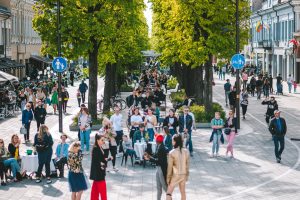
How does one measure the success of a project as ambitious as the European Capital of Culture? Is it the astonished foreign guests and the participating artists praising each other? In a way. However, the real achievement and strength are the local communities that got closer and became more inspired during the process. This is why creativity as part of everyday life is included in the core formula of Kaunas – European Capital of Culture 2022.
Five Years Together
‘We the People’, often called ‘Fluxus Labas!’, is one of the broadest of the Kaunas 2022 programmes, and over five incredibly intensive years of day-to-day activities, it has had an impact on the majority of communities in Kaunas, promoting the idea that residents themselves are capable of addressing challenges and making change.
‘The basis for our programme’s success rests on shared human and European values: the openness of people and communities toward one another, and to diversity, innovation, and creative solutions; inclusion of different people and organizations; building and maintaining interpersonal relationships; and promoting dialogue and co-creation,’ Greta Klimavičiūtė-Minkštimienė, the curator of the communities programme, believes.
The curator stresses the rest of the unique features of the communities programme, including its experimental spirit, sense of adventure, and playfulness: ‘By embracing these principles, we symbolically follow in the footsteps of George Maciunas – the founder of the Fluxus movement and a Kaunas native – and his ability to see the world and its challenges differently – more playfully and more simply, from a more human perspective.’
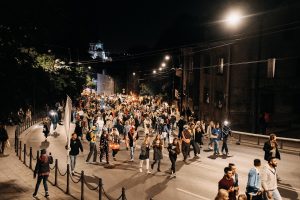
More and More Happy Courtyards
The courtyard project has become the pride of Kaunas 2022. Many have copied one of the most successful pandemic-era projects created in the European Union, presented at international awards ceremonies.
Since 2019, ‘Fluxus Labas!’ has been encouraging residents to engage with their neighbours to change their surroundings, take responsibility for them, and find creative solutions to the challenges they face. During Lithuania’s first quarantine in 2020, ‘Fluxus Labas! Kiemas’ adapted to the changing situation and launched the Culture to the Courtyards project. Different performers presented shows to residents in surrounding apartment buildings, allowing audiences to enjoy culture safely in their yards, from their windows and balconies.
In 2022, the program will invite one and all to as many as 80 courtyards in 11 elderships in Kaunas to enjoy the gift of shows by theatre, dance, contemporary circus, music, and other performers.
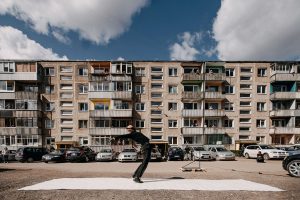
Laboratories Producing Happiness
The Fluxus Laboratories is a particular branch of the ‘Fluxus Labas!’ project that trains community facilitators. These people have now spread out through the city. Their goal is to bring together formal and informal communities, city residents, and organizations in different sectors and encourage them to become involved in community cultural and artistic activities and promote such activities themselves in specific neighbourhoods.
In 2022, the Fluxus Laboratories will ‘explode”’ and present unique community cultural and artistic projects in many different neighbourhoods throughout Kaunas. As early as April 23, the Šilainiai Urban Eco Festival, the only one in Lithuania, will unite residents and various organizations. The festival promises to impress with Šilainai natural and landscape design installations, lectures, and educational programmes.
On June 10–12, the community of Draugystės (Friendship) Street in the industrial part of Kaunas will present an interactive cultural and local creative game called The Art of Friendship. Visitors will be invited to enter sites that have been previously off-limits, learn more about welcoming residents and workers and their co-creations, and participate in playful and artistic activities.
On June 11, one will have the chance to walk through Eiguliai in a way they have never had before. Collaborating with different street artists, the community has created drawings that reflect its identity and now invites you to explore them on this colourful and musical walking tour.
On June 18, the Dainava neighbourhood community, collaborating with professional performers, artistic groups, and volunteers, will invite everyone to a midsummer mystery in Draugystės (Friendship) Park.
The real Midsummer will be celebrated in the impressive Šančiai Festival. Initiatives promoted in Šančiai over the past four years will all come together at this three-day event.
One will be able to visit a former gunpowder warehouse, ‘Parakas’, and celebrate what Lithuanians call Joninės by immersing into a surprising opera of imagery and watching a performance of ice and fire. Moreover, artists and residents will revive the old Šančiai barracks from their deep sleep and invite everyone to creative workshops, musical performances, and tours.
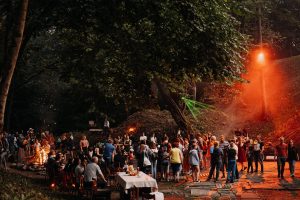
‘Just Come’, a poetry festival by the Gričiupis community, will take place in Kovo 11-osios (March 11) Park on July 23 and will also feature a ceramics collection of more than 700 works of art crafted by members of the community as they listened to poetry.
On July 9, the festival ‘Forest of the Senses’ will take place in the Panemunė pine grove and will join professional artists, naturalists, and herbalists to create land art and sound installations.
Courtyard Gallery (Kiemo galerija), a new legend of old Kaunas, will invite people to experience colourful creations as well as the retelling of local stories in central Kaunas and its Old Town courtyards on July 16.
On August 6, the community of Žaliakalnis will host a dancing tour, ‘Step by Step’, that will directly involve professional artists, residents, and visitors to Kaunas, calling them to learn more about the living memory and history of Žaliakalnis and its local mythical creature – Kaukas.
August will also be a perfect time to meet by the Kaunas Reservoir, colloquially called the Kaunas Lagoon. The community of Petrašiūnai will host the celebration on August 14 to emphasize the vital role the lagoon plays as part of the face of Kaunas and reveal the whole range of activities that take place around this body of water.
On August 20, it will be time to discover the Vilijampolė eldership. The artists’ collective God’s Entertainment (Austria) performance will open the ‘Under the Carpet’ installation. One of the show’s elements will be weaving a carpet by the people of Kaunas themselves. On the same day, Culturethon, a festival of sport and art, will travel from lake Lampėdis to the banks of river Neris.
A private music school located in Šilainiai, Jazz Academy, and composer Hara Alonso are of an experimental composition project titled ‘The City Composing in Kaunas’, a work of music created with the people of Kaunas. Its results will be presented on September 10 at the Ninth Fort.
In Aleksotas, audiences will be invited to view an installation assembled from residents’ stories on September 10. The arts group Effetto Larsen (Italy) will create an emotional map of the area based on the memories of those who live here and the experiences of specific places in the neighbourhood. The final result will be an installation modelled as an emotional, interactive journey through the Aleksotas neighbourhood. On September 18, the community of Aleksotas will host the ‘Flying Through Time’ interdisciplinary festival. Different spaces throughout Aleksotas will become stages for theatrical, musical, and other types of performances.
The Šančiai Cultural Courtyard Festival will be yet another occasion to come back to this colourful neighbourhood. On September 14–15, the celebrations will take place near a traditional wooden house. They will combine two initiatives: Elder Stories, a premiere showing of a documentary art film, and a music festival.
Time for Festivals and Celebrations
‘Fluxus Labas!’ is responsible for the birth of the artsiest sports in the world. It’s climbing up Parodos Hill in every possible way except traditionally. The challenge is also the culmination of the Fluxus Festival that will take place on September 10. Each year, Parodos Hill is closed for transport for precisely 22 minutes, and the starting point of the climb is at the Geoge Maciunas Square. After finishing, the participants will take part in a Fluxus carnival. People in Kaunas begin preparing for this celebration well in advance, creating costumes and building props.
A two-day Communities Forum at the Zapyškis Church of St. John the Baptist, Kaunas District, will take place before the Fluxus Festival to discuss results achieved in Kaunas and the Kaunas District over the past five years, talk about newly created and tested models and methods for engaging with communities, and about the changing view of community-based art, its benefits, and financing. The second day of the forum will be devoted to discussing the vitally important subject of including Kaunas’ rivers and communities in river revitalization.
Of course, many more festivities are planned for the whole of 2022. On May 20, for example, the place to be will be Laisvės Alėja and Vilniaus Street, the central axis of Kaunas connecting Soboras and Kaunas Town Hall. The Courtyard Festival will foster community-building and friendship among people living in the city of Kaunas and the surrounding region. It will present an opportunity to celebrate International Neighbours’ Day. The event will be marked by music played in the most unexpected places and different creative installations and performances.
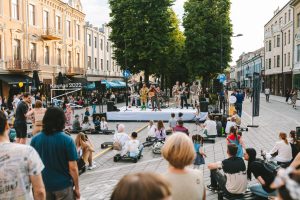
May 21 is the official date of Putvinskio Street Day. Since 2017, once a year, on one Saturday in May, rain or shine or pandemic, all of V. Putvinskio Street comes together to celebrate the neighbourhood and its rich history.
The third event of the main weekend in May is called ‘Celebrate the River’. People will be invited to take part in cultural walks along the Nemunas and Neris and then share in the celebration when these two routes meet at Kaunas Santaka Park, the confluence of the two rivers. This event will allow residents and guests to reengage with the city’s rivers and their banks, learn more about different Kaunas communities and discover the city anew, but this time from the water. Later in Summer 2022, initiative TẽKA will launch a social game aimed at connecting river banks.
Contemporary Vibes in Kaunas District
‘Relationships between cities and their surrounding areas are interesting and complicated throughout Europe, and everywhere they’re influenced by culture. This is why listening to the needs of our region was the first task of Kaunas 2022. Another objective was adapting the programme tools of cultural capital to those needs’, Lukas Alsys, curator of the Kaunas District programme, stresses.
He believes human relationships and coming together play an essential role in the Kaunas District, like nowhere else. This is why these district projects have created unique, one would even say passionate, partnerships. The best example is Italian contemporary circus director Roberto Magro, who is now beloved by communities in the district. He will come back to direct a travelling contemporary circus performance in Batniava eldership at the beginning of the summer, and then will work in Linksmakalnis for an ‘angelic’ show. That’s just one of many reasons to follow the artistic travels beyond city limits.
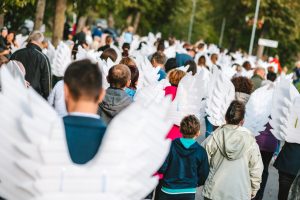
Jeans and Steampunk, Time Travel and Rock Music
The work of the Capital of Culture in the Kaunas District is taking place along several approaches. One of these is a community project called Contemporary Neighbourhoods, involving fifteen local municipal jurisdictions within the Kaunas District. The essence of the project is simple: local jurisdictions called ‘seniūnijos’ (elderships) strengthen communities and address rising challenges through culture.
From June to September 2022, the elderships invite everyone to feel the strong pulse of community and creativity in the Kaunas District and attend the main Contemporary Neighbourhoods events.
Ežerėlis will present a series of photography exhibitions at a newly established community gallery and an alternative reality audio guide created by artist Žygimantas Kudirka. The project launch is scheduled for June.
On June 11, The community of Kulautuva will participate in a theatrical musical performance about the history of the resort town. It will be accompanied by various works of art in different public spaces by the Nemunas River.
The Raudondvaris community and choreographer Marius Pinigis and event director Eglė Valadkevičiūtė invite everyone on a beautiful tour – a journey through time. This event’s primary form of expression will be presented in a theatrical night-time walk on June 17.
Between June 30 and July 3, historic locations in Karmėlava will be presented through the increasingly strong Street Rock Festival, crowned by a combined environmental artwork called Flying Cepelinai, created by artists from Lithuania and Luxembourg: Algimantas Šlapikas and Serge Ecker.
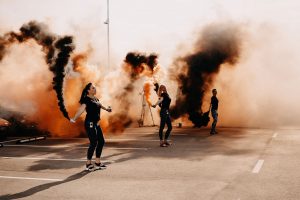
A great time to discover Babtai eldership will be July. The community decided to revive an old trolleybus from the streets of Kaunas. The trolleybus became a creative laboratory for everyone to attend.
Also in July, Vilkija will celebrate Midsummer, and their centrepiece will be a ferry connecting both sides of the Nemunas River. The celebration will include concerts, theatrical performances, and art installations.
In August, the communities from around Garliava will organize a Steampunk Festival, inviting local communities and guests to a magical fiesta. The festival aims to introduce visitors to the Steampunk movement, and its programme will give everyone a chance to plunge into this fantastical world and liberate their imaginations and creativity.
The same month, the neighbourhood of Ringaudai will present their eldership through the Ringaudai Almanac, created by the community and artist Paulina Ružauskaitė. The almanac will be presented along with an interactive sculpture dedicated to this community.
On September 3, the Lapės (literally foxes) town will host the now annual Lapės Sustainability Festival! Did you know that, in 2021, the community created a recreational space from old jeans?!
Linksmakalnis and the charismatic abovementioned Roberto Magro (Italy) have created a show about angels. Nobody knows yet what kind of show this will be. And they can’t possibly know since co-creation means working without a planned script! All we know is that show will be presented in September.
At the heart of the identity of Rokai is the uninterrupted 400-year-old history of its brickyard and the clay found all around the town. In recent years, community members have been introduced to various ceramic techniques and have worked together to create the Clay Road. On September 3, the community will unveil a mythical sculpture and invite guests to a unique show.
With the help of artists Enrika Striogaitė and Remis Ščerbauskas, the harmonious Kačerginė resort town by Nemunas River plans to create a collection of stories inspired by the experiences of its residents. Attend the presentation and a classical music concert on September 4.
Located near the 11th Fort of Kaunas Fortress, Akademija will present a musical production at the military heritage site. Make sure you stop at the sustainable shop Lokali: Made in Akademija, established by the community, for souvenirs. See you on September 10?
The Domeikava eldership has chosen to develop lively activities, roles, and orienteering games. The project Let's Play Domeikava aims to experience and learn more about this Contemporary Neighbourhood. The launch is scheduled for September 17.
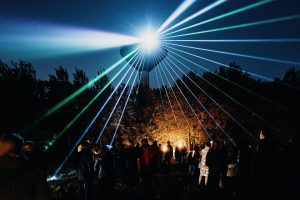
A Culture Boat and A Path of Emerald
Ever searched for emeralds? In the context of Kaunas 2022, emeralds are new art objects that will appear in the most unexpected places. Some of them have been under creation from the start of the programme; others rely on objects in the Kaunas District for their existence, transforming them in a contemporary way. The emeralds will appear in 9 elderships of Kaunas District.
A unique river engineering and landscape design project in Europe, Nemuno7, will serve as a public cultural space and will be officially opened in May. Located in Zapyškis, the dredger dates back to 1965! Instead of dismantling the unused object, a more sustainable solution was devised: to create a new, more relevant role and transform it into a cultural space, inviting the public to explore the subject of water from the perspective of art, history, and science. The Nemuno7 dredger will also have space for artistic residencies.
A tool to discover Vandžiogala, scheduled to launch in Autumn 2022, is a unique diary by Mindaugas Lukošaitis. Using material gathered around the small town of Vandžiogala, the artist added his own drawn stories to the area’s authentic landscape, presenting audiences a very personal code by which they can “read” what he has seen. This project was initiated by Kaunas 2022 programme Memory Office for its CityTelling Festival.
Also organised by the Memory Office, the Lithuanian Klezmer Orchestra’s tour of towns in the Kaunas District will rekindle local communities' memory and culture. Did you know that, before the Second World War, the towns of the Kaunas District were home to significant Jewish communities? The orchestra’s bus will stop in Čekiškė, Vandžiogala, Vilkija, Babtai, Kačerginė, Kulautuva, and Zapyškis. Performances will be accompanied by tours exploring the not so distant past of these towns.
For the European Capital of Culture programme, the 17th Kite Festival in Zapyškis will feature creative workshops, kite and paper aeroplane competitions, a postal postcard service, and soap bubbles. Artists and kite masters will create large and impressive banner kites, and everyone will have a chance to help make the community kite.
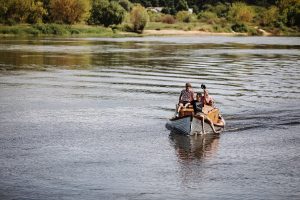
Yet another legendary festival, this time launched by the Kulautuva community, will present a rich musical programme in 2022. Akacijų alėja, an event for sung poetry, will present a series of concerts in four towns along the Nemunas River. Then, the main festival event will take place in Kulautuva. Instead of the usual one-day event, the festival will span through June and July.
Time to revisit the Kaunas Reservoir… and discover its Atlantida-like history. Everyone who comes to the Footsteps at the Bottom of the Lagoon festival on August 27 will get the chance to feel as if they’ve become part of the now flooded villages that once existed here. This event will have a bit of everything: songs, stories, and folklore from flooded villages, contemporary music, and innovative technological solutions.
On the same day and nearby, yet another exciting event to attend will be the Girionys Land Art Festival. The identity of the town lies in its beautiful nature and the expanse of the Kaunas Lagoon. Objects found in nature and ideas shared by residents will all be part of the co-creation process of land art objects.
Skanaus: European cuisines 2022, a food and culture festival, is scheduled for September 7–11 in Garliava. It will include presentations of cultures and the latest gastronomic trends from abroad, cooking lessons by restaurant chefs, culinary film production, family entertainment, concerts by Lithuanian and foreign musical performers, and talks shows, lectures, and all sorts of competitions.
Tadas Ivanauskas, the Lithuanian Zoo and Zoological Museum founder, lived in a villa called Obelynė in Akademija town. In July and August, a series of open-air events will be held to represent the cultural heritage of the Obelynė estate and its recently opened museum, park, and gardens. The main event is planned for September 17.
In August, the residents of Kaunas District and their guests will be invited to attend Mikado, a philosophical exploration of the connection between humans, their tools, and the virtual world. Produced by Šeiko Dance Company, it is choreographed by Vittoria de Ferrari Sapetto (Brazil – Italy – Belgium) and Andrea Valfre (Italy) and will be performed by an international team.


